
|
|
Kanishka I is no doubt the most famous Kushan king and even perhaps the greatest, although his son Huvishka's empire was probably bigger (and coinage more copious).
He owes much of his fame to his place in early Buddhist literature, where he is mentioned as a patron of Buddhism and the convener of the Fourth Buddhist Council. He is
supposed to have built in Peshawar a great stupa holding relics of the Buddha. More importantly, Kanishka is central to historical discussions of the time because he is known
to have started an era. Establishing the date of Kanishka has been a major point of historical research for over 100 years.
The uncertainty over this date is now finally coming to an end. Although there are a few dissenting voices still holding out for alternatives, most authors have now accepted
the argument of Harry Falk that the Kanishka era should be dated to the year 127. Given that we have dated inscriptions naming Kanishka as the king with dates as high as
23, this would put Kanishka's reign at c. 127-150.
The most important inscription of Kanishka is the Rabatak Inscription. This established his geneaology, with Kujula Kadphises, Vima Takto (or Takha) and Vima Kadphises
being named as his immediate ancestors. It is this part of the inscription that has received the most attention. But there are at least three other very important revelations in the
inscription. First, it clearly establishes that Kanishka created a new era, because it is dated in year one. Second, it shows Kanishka to be a nationalist: he explicitly states that
he is recording this inscription in the Arian (or Bactrian) language. Until that time, Greek had been the lingua franca of the region and indeed the first coins of Kanishka
carry Greek legends as did the coins of all his forebears (see images below). But after the brief early issues, Kanishka's coins switch to carrying Bactrian legends. For example,
the word "King," rather than being recorded as the Greek BAΣIΛEΩΣ (Basileus), is now rendered Shao.Third, it suggests that, at least at the time
his reign started, Kanishka was a follower of Iranian religion since he gives prime place among the listed pantheon to the Goddess Nana, but nevertheless honored deities from
different traditions. These lessons from the Rabatak Inscription are reflected in Kanishka's wonderful coinage. As mentioned earlier, his early Greek issues feature Greek legends
and Greek versions of the deities. They are quickly replaced by Bactrian issues with Bactrian legends and the Iranian versions of the same deities. In addition, deities from
different traditions are featured on the coinage.
|
 |
Year One Greek Coinage |
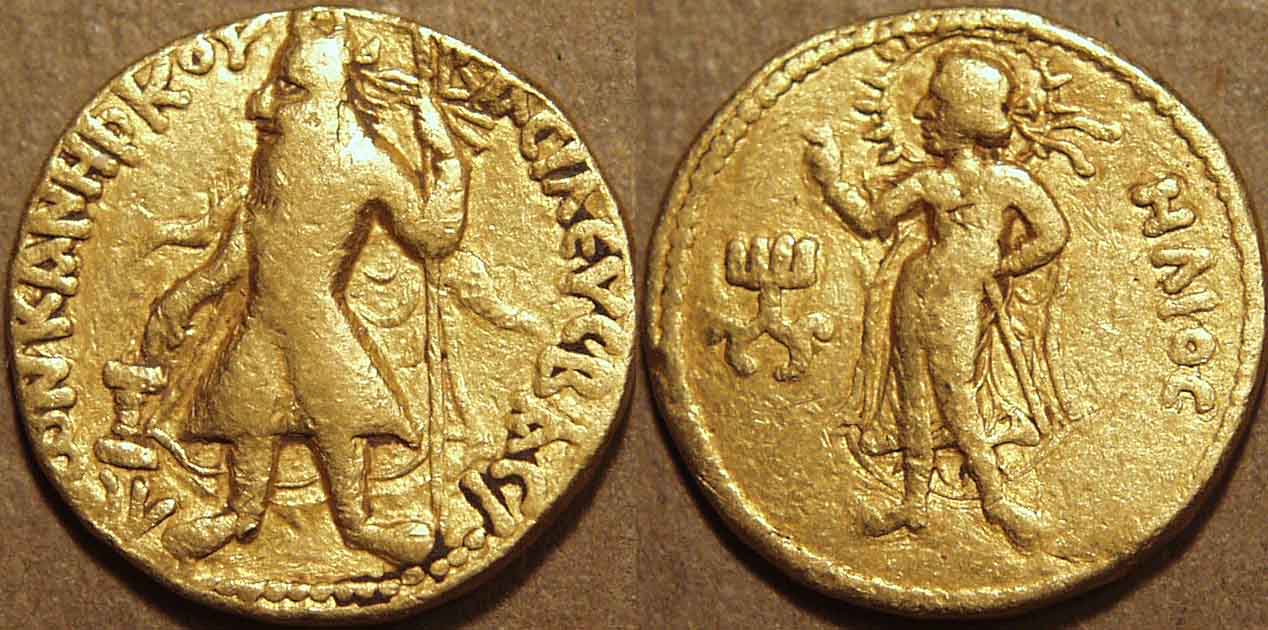
| Gold dinar, c. 127 CE
Weight: 7.87 gm., Diam: 20.5 mm., Die axis: 12 o'clock
Crowned, diademed king standing facing, holding spear and sacrificing at altar at left,
Greek legend around: BACIΛEYC BACI ... ΛEWN KANHþKOY
(King of Kings Kanishka Kushan) /
Solar deity Helios standing facing, with head turned to left, one hand on hip, the other raised in blessing,
Greek legend right: HΛIOC, tamgha at left
Göbl 25 |
 |
Kanishka did not issue any double dinars. Only dinars are known for the year one issues, although gold quarter dinars
were also issued later. The reverse deities represented in the known first year Greek issues were: Anemos, Helios, Hephaistos, Nana, and Salene. Compare the representation
of the Greek Helios on this rare first year issue with the Iranian solar deity Mithra (Miiro) on the later issue shown below ... they are identical, demonstrating that they were seen as
the same god. |

| AE didrachm or half unit, c. 127 CE
Weight: 8.91 gm., Diam: 22-23 mm., Die axis: 12 o'clock
Crowned, diademed king standing facing, holding spear and sacrificing at altar at left,
Greek legend around: BACIΛEYC BACI ... ΛEWN KANHþKOY
(King of Kings Kanishka Kushan) /
Solar deity Helios standing facing, with head turned to left, one hand on hip, the other raised in blessing,
Greek legend right: HΛIOC, tamgha at left
Göbl 766, MAC 3065-69 |
 |
The year one bronze issues were confined to the didrachm (or half unit) denomination, and the only reverse deities known
to have been featured are Helios and Nana. The designs were just copied from the gold issues. |
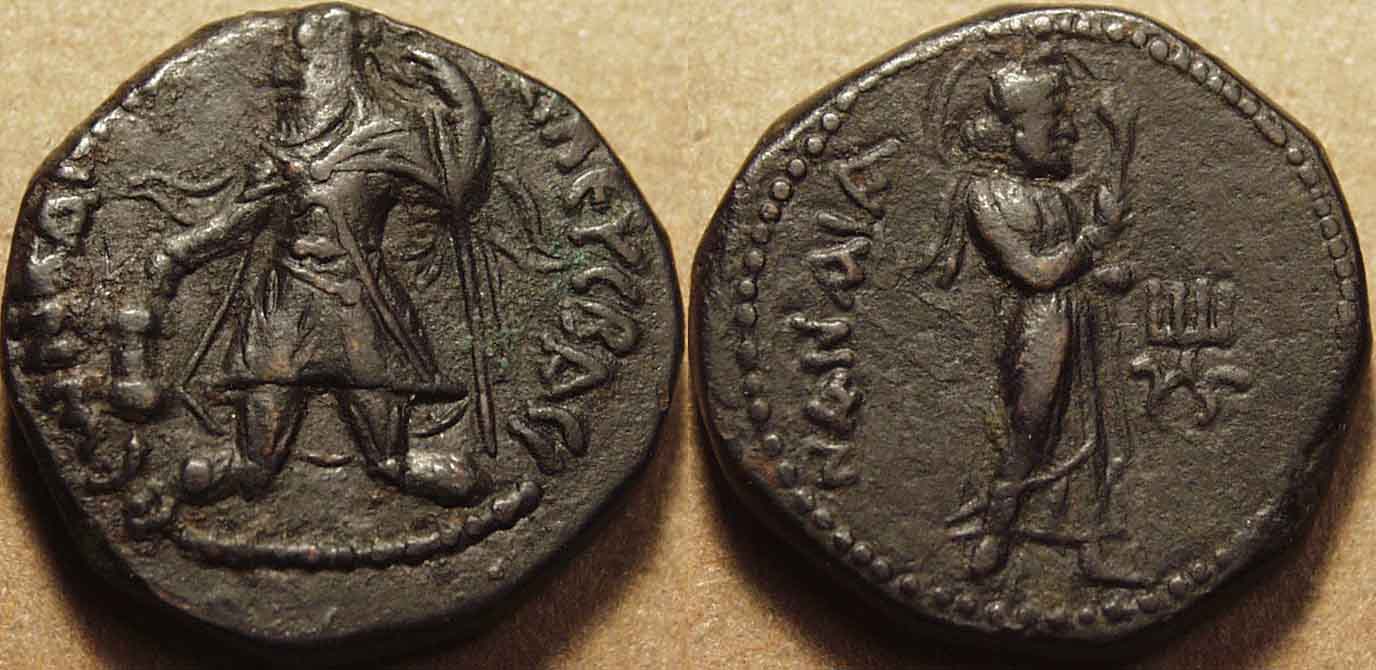
| AE didrachm or half unit, c. 127 CE
Weight: 9.00 gm., Diam: 22 mm., Die axis: 12 o'clock
Crowned, diademed king standing facing, holding spear and sacrificing at altar at left,
Greek legend around: BACIΛEYC BACI ... ΛEWN KANHþKOY
(King of Kings Kanishka Kushan) /
Goddess Nana standing right, nimbate, holding protome of animal,
Greek legend left: NANAIA, tamgha at right
Göbl 767, MAC 3071-73 |
 |
Bactrian issues: Gold |
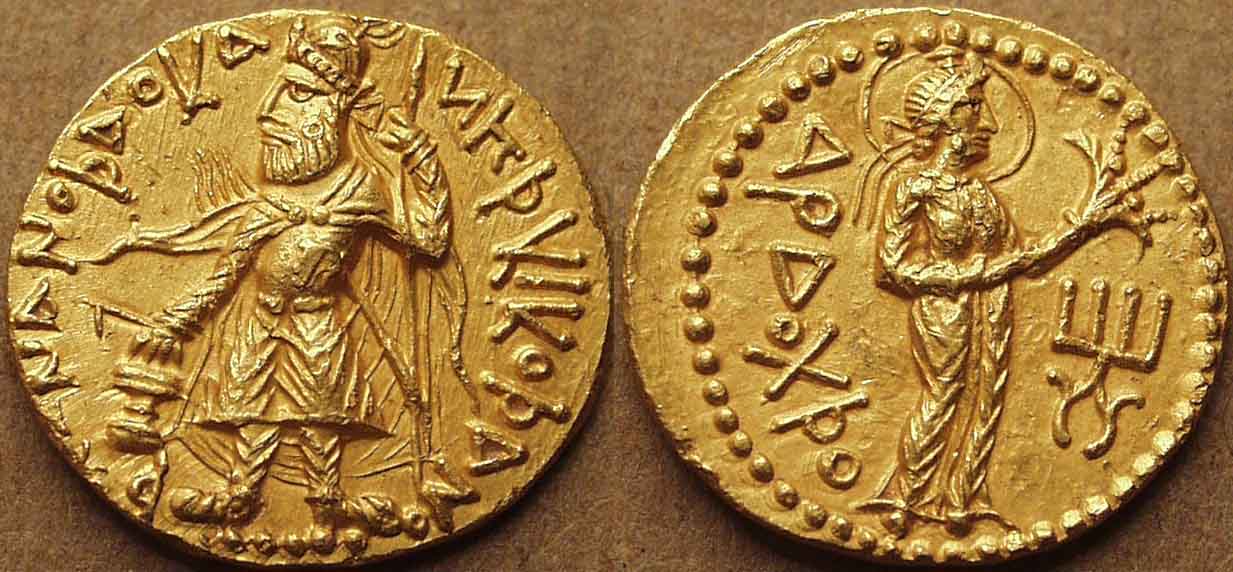
|
Gold dinar, c. 128-150 CE
Weight: 7.94 gm., Diam: 20-21 mm., Die axis: 1 o'clock
Crowned, diademed king standing facing, holding spear and sacrificing at altar at left,
Bactrian legend around: þAONANOþAO KA ... NηþKI KOþANO
(King of Kings Kanishka Kushan) /
Goddess of plenty Ardochsho standing right, holding cornucopia,
Bactrian legend left: APΔOXþO, tamgha at right
Göbl 71 |
 |
Kanishka introduced Ardochsho on coinage for the first time ... she would go on to become one of only two deities
featured on late Kushan coinage. Deities known to have appeared on Kanishka dinars are: Ardochsho, Athsho, Buddha, Lrooaspo (Druvaspa), Manaobago, Mao,
Mazdoanao, Miiro (Mithra), Nana, Oesho (Shiva?), Orlagno, and Pharro. |

|
Gold dinar, c. 128-150 CE
Weight: 7.98 gm., Diam: 20 mm., Die axis: 12 o'clock
Crowned, diademed king standing facing, holding spear and sacrificing at altar at left,
Bactrian legend around: þAONANOþAO KA ... NηþKI KOþANO
(King of Kings Kanishka Kushan) /
God of metals Athsho standing facing, with head turned to left, one hand on hip,
the other holding out diadem, Bactrian legend right: AΘþO, tamgha at left
Göbl 33 |
 |
Athsho, god of fire, metals and the forge, was the Iranian replacement for the Greek god Hephaistos. |
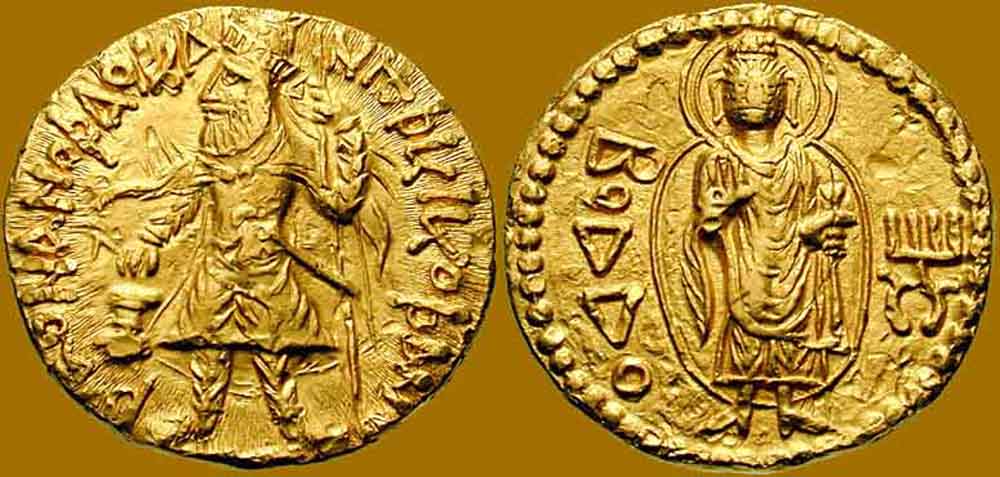
|
Gold dinar, c. 128-150 CE
Weight: 7.93 gm., Diam: 20 mm., Die axis: 12 o'clock
Crowned, diademed king standing facing, holding spear and sacrificing at altar at left,
Bactrian legend around: þAONANOþAO KA ... NηþKI KOþANO
(King of Kings Kanishka Kushan) /
The Buddha standing facing, left hand holding robe, right hand in abhayamudra, "have no fear,",
Bactrian legend left: BOΔΔO, tamgha at right
Göbl 66 |
 |
This is one of the earliest physical representations of the Buddha in any medium. (Photo courtesy CNG.) |
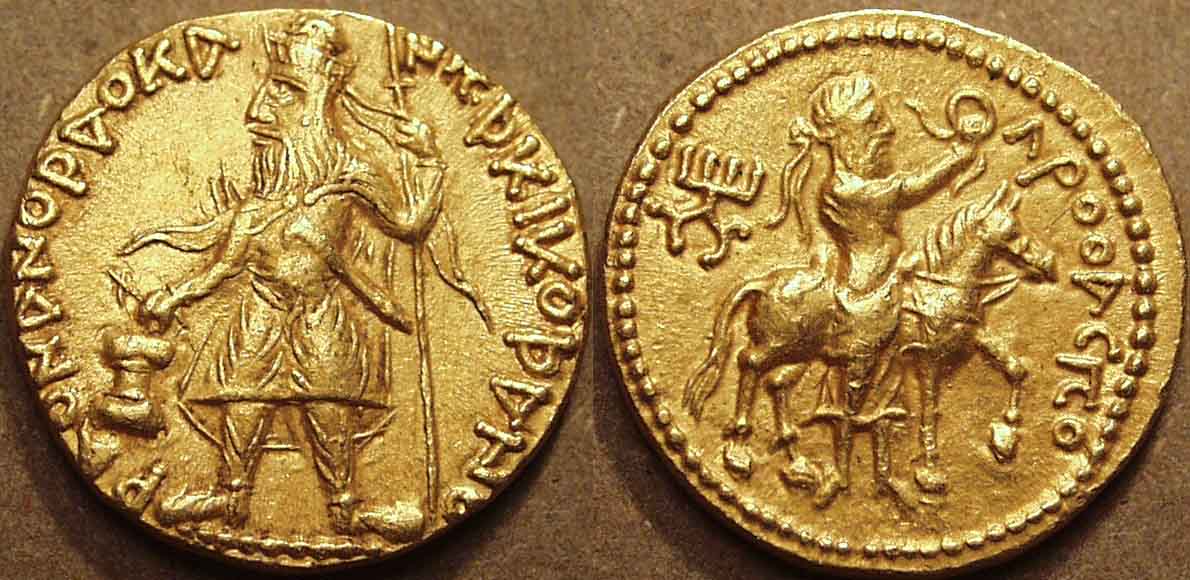
|
Gold dinar, c. 128-150 CE
Weight: 7.96 gm., Diam: 20 mm., Die axis: 12 o'clock
Crowned, diademed king standing facing, holding spear and sacrificing at altar at left,
Bactrian legend around: þAONANOþAO KA ... NηþKI KOþANO
(King of Kings Kanishka Kushan) /
Protector of the health of animals, Druvaspa standing right, holding out diadem, with horse right behind,
Bactrian legend right: ΛPOOASΠO, tamgha at left
Göbl 57 |
 |
Although the legend reads Lrooaspo, it was surely meant to be Drooaspo ... the Δ has been replaced by a Λ. |
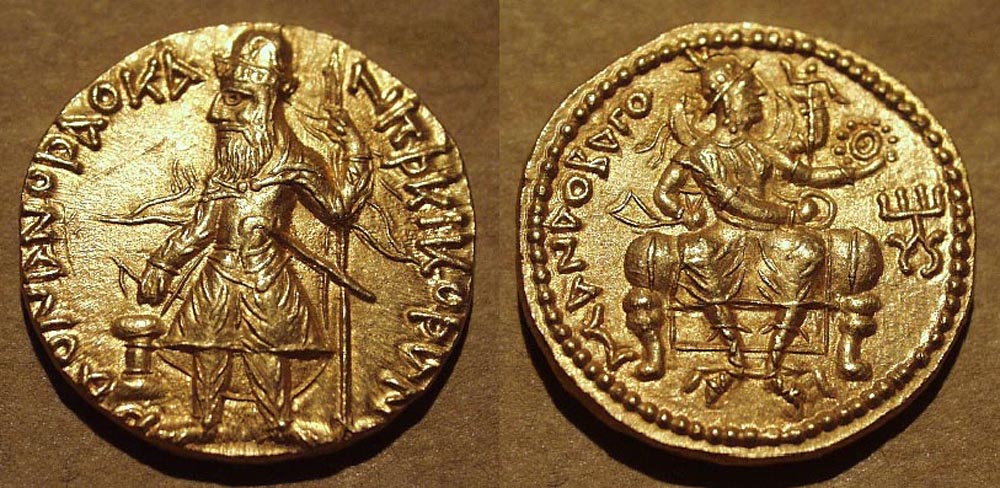
|
Gold dinar, c. 128-150 CE
Weight: 7.99 gm., Diam: 19 mm., Die axis: 12 o'clock
Crowned, diademed king standing facing, holding spear and sacrificing at altar at left,
Bactrian legend around: þAONANOþAO KA ... NηþKI KOþANO
(King of Kings Kanishka Kushan) /
Four-armed god Manaobago enthroned facing, with head turned to right, holding various attributes,
Bactrian legend left: MANAOBAΓO, tamgha at right
Göbl 59 |
 |
The identity of Manaobago has still not been definitively established. The name suggests the Avestan (Zoroastrian)
deity Vohu Mano, the "Lord of Good Thought." However, there are several problems with this attribution, including the presence of four arms (unthinkable in a Zoroastrian
deity and suggesting an Indian origin) and the presence of the lunar crescents on the shoulders. The Vedic Mananas Pati is a possible candidate ... he is
the lord of the mind and of dreams, and therefore of the night. The lunar crescents and the title Manaobago = Lord of the mind seem to fit this well. The word Bago means
"god" or lord," so we could easily have Mananas Pati = Mananas Bago = Manaobago. |
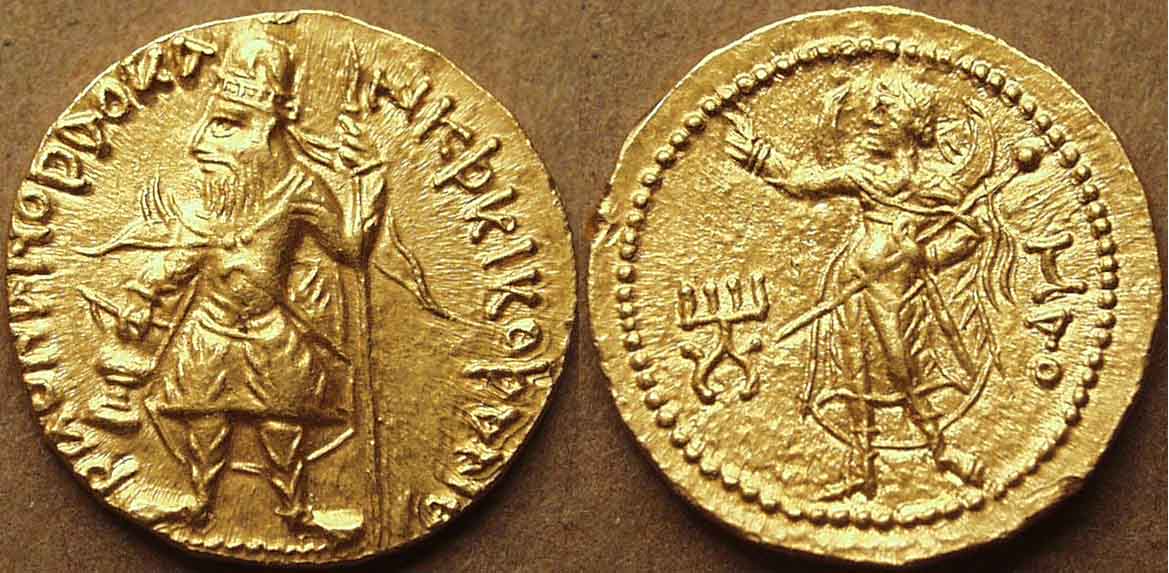
|
Gold dinar, c. 128-150 CE
Weight: 7.99 gm., Diam: 20 mm., Die axis: 12 o'clock
Crowned, diademed king standing facing, holding spear and sacrificing at altar at left,
Bactrian legend around: þAONANOþAO KA ... NηþKI KOþANO
(King of Kings Kanishka Kushan) /
Lunar deity Mao standing left, holding sceptre and holding out hand in blessing,
lunar crescents on shoulders, Bactrian legend right: MAO, tamgha at left
Göbl 53 |
 |
The warlike lunar deity Mao replaced the Greek Salene. |
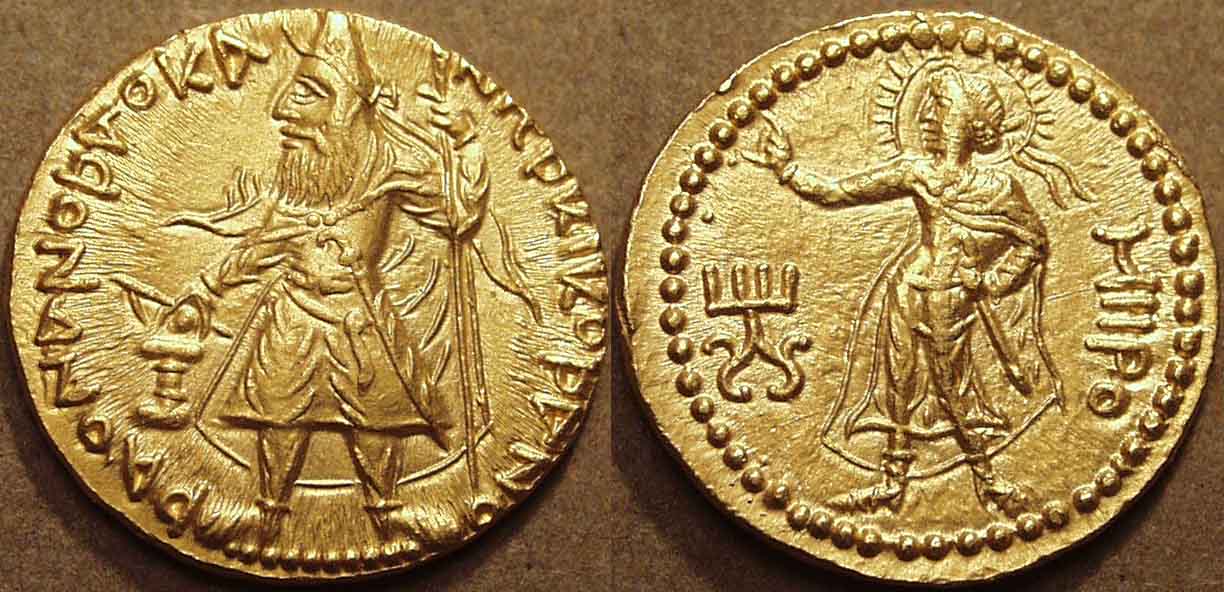
|
Gold dinar, c. 128-150 CE
Weight: 7.97 gm., Diam: 20 mm., Die axis: 12 o'clock
Crowned, diademed king standing facing, holding spear and sacrificing at altar at left,
Bactrian legend around: þAONANOþAO KA ... NηþKI KOþANO
(King of Kings Kanishka Kushan) /
Solar deity Mithra standing left, holding sword hilt and holding out hand in blessing,
radiate nimbus around head, Bactrian legend right: MIIPO, tamgha at left
Göbl 31 |
 |
Mithra replaced the Greek Helios ... compare this coin with the Helios coin above, with the identical iconography, only a
different name. |
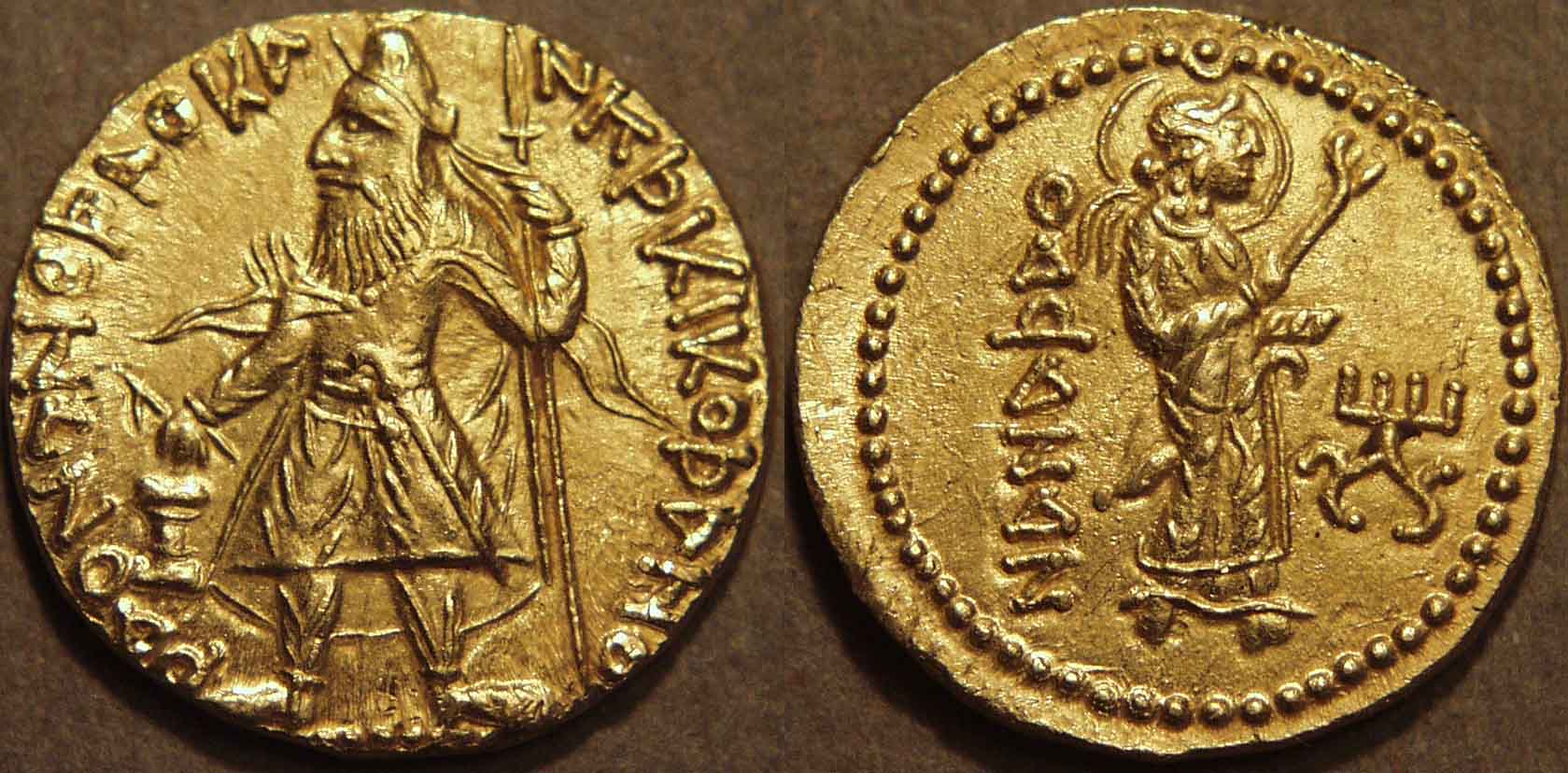
|
Gold dinar, c. 128-150 CE
Weight: 8.01 gm., Diam: 20 mm., Die axis: 12 o'clock
Crowned, diademed king standing facing, holding spear and sacrificing at altar at left,
Bactrian legend around: þAONANOþAO KA ... NηþKI KOþANO
(King of Kings Kanishka Kushan) /
Goddess Nana standing right, nimbate, holding bowl and protome of animal,
Bactrian legend left: NANAþAO, tamgha at right
Göbl 36 |
 |
Nana occupies a special place in Kanishka's coinage. She is the only Iranian deity to be included in the Year One Greek
coinage, and she is given pride of place in the Rabatak Inscription as the one by whose grace Kanishka ruled. Most authors think she is the same as the goddess of fertility,
Anahita, but this is by no means certain. Note that she is called here Nanashao, King Nana. |
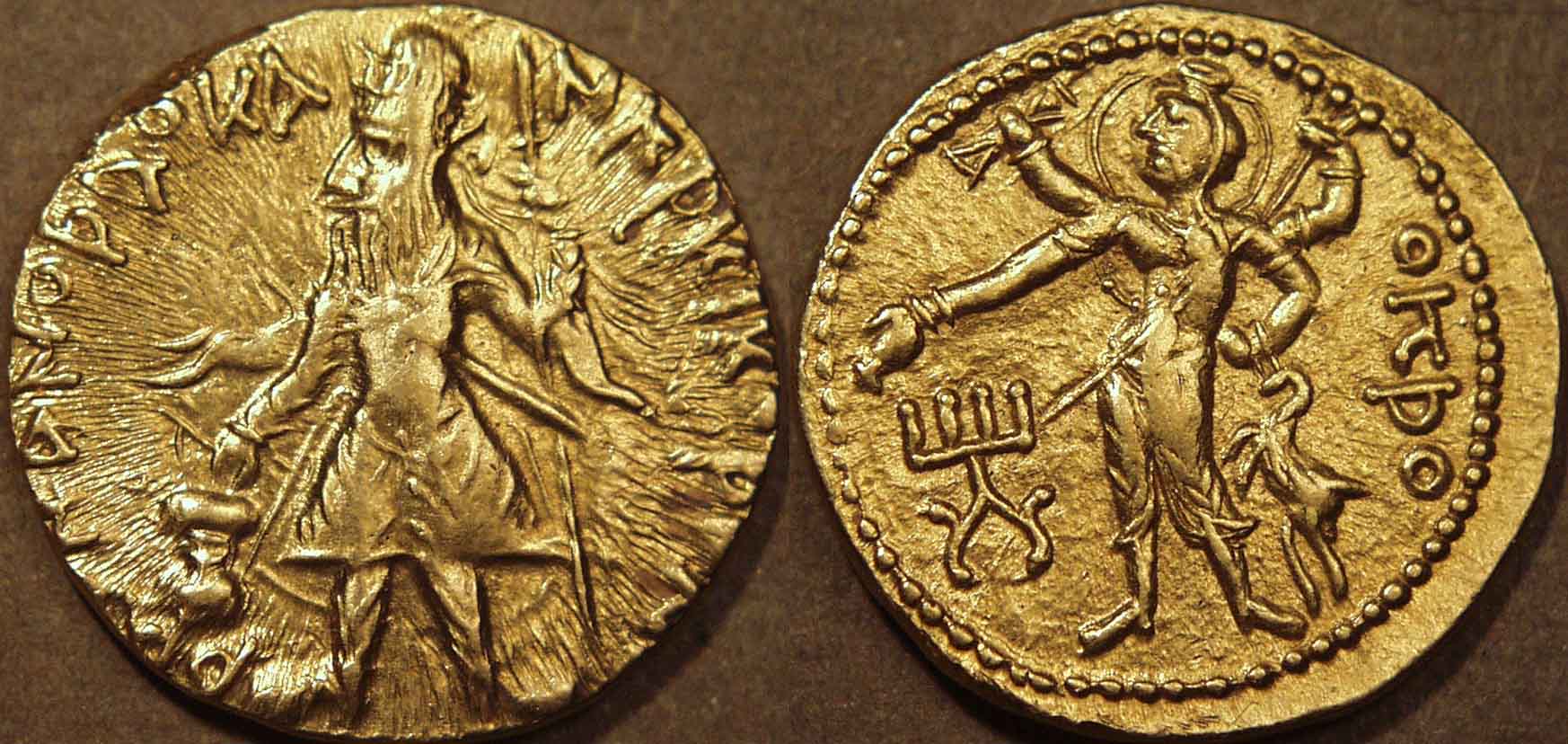
|
Gold dinar, c. 128-150 CE
Weight: 8.01 gm., Diam: 20-21 mm., Die axis: 12 o'clock
Crowned, diademed king standing facing, holding spear and sacrificing at altar at left,
Bactrian legend around: þAONANOþAO KA ... NηþKI KOþANO
(King of Kings Kanishka Kushan) /
Four-armed Oesho (Shiva?) standing facing, head turned to left, nimbate, holding various attributes,
Bactrian legend right: OηþO, tamgha at left
Göbl 62 |
 |
The legend on this coin reads "Oesho," which suggests the Iranian wind god Wesho,while the image seems to be that
of Shiva with his various familiar attributes: trident, deerskin, damaru or drum (also seen as a thunderbolt) and water pot. It is possible that this image demonstrates that
the two deities, Wesho and Shiva, were in the process of being merged at this time and place. |
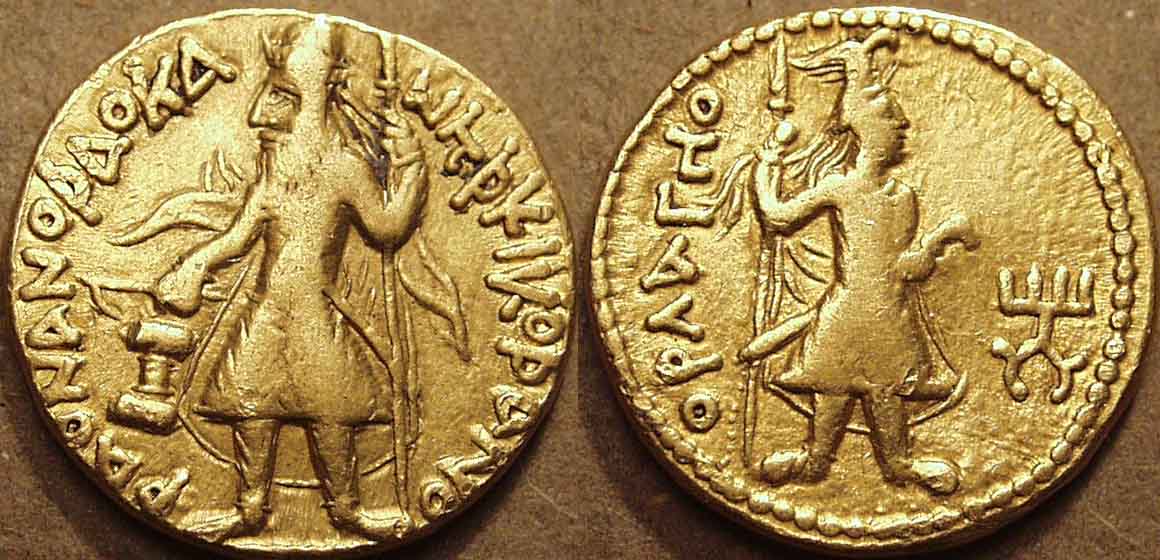
|
Gold dinar, c. 128-150 CE
Weight: 7.88 gm., Diam: 20 mm., Die axis: 12 o'clock
Crowned, diademed king standing facing, holding spear and sacrificing at altar at left,
Bactrian legend around: þAONANOþAO KA ... NηþKI KOþANO
(King of Kings Kanishka Kushan) /
Orlagno standing right, holding spear and sword hilt, nimbate, wearing a bird head-dress,
Bactrian legend left: OPΛAΓNO, tamgha at right
Göbl 63 |
 |
Orlagno is seen as Verethraghna, the personification of victory. The bird in his head-dress is Varagna, possessed of
special powers. |

|
Gold quarter dinar, c. 128-150 CE
Weight: 1.98 gm., Diam: 12 mm., Die axis: 12 o'clock
Crowned, diademed king standing facing, holding spear and sacrificing at altar at left,
Bactrian legend around: þAONANOþAO KA ... NηþKI KOþANO
(King of Kings Kanishka Kushan) /
God of metals Athsho standing facing, with head turned to left, one hand on hip,
the other holding out diadem, Bactrian legend right: AΘþO, tamgha at left
Göbl 47 |
 |
Quarter dinars are known with the following reverse deities: Athsho, Buddha, Mao, Mithra, Nana, Oesho, and Pharro. |
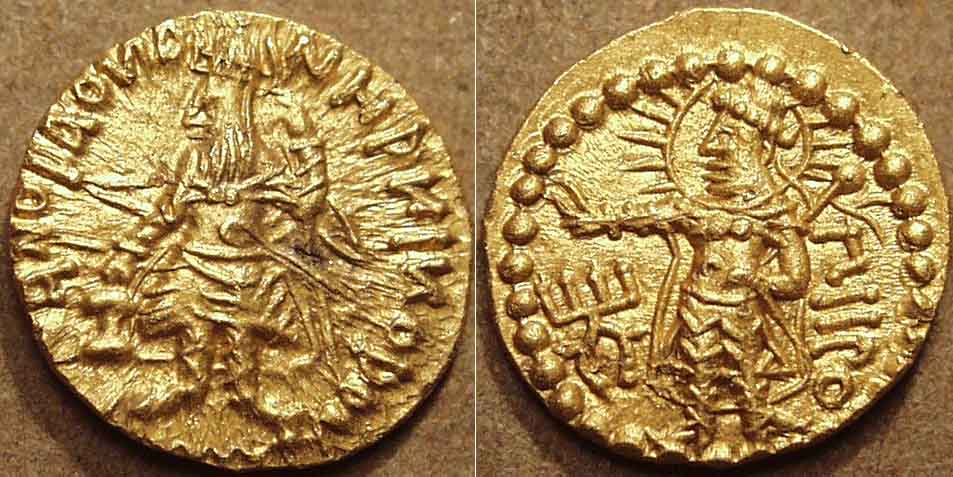
|
Gold quarter dinar, c. 128-150 CE
Weight: 1.98 gm., Diam: 13 mm., Die axis: 12 o'clock
Crowned, diademed king standing facing, holding spear and sacrificing at altar at left,
Bactrian legend around: þAONANOþAO KA ... NηþKI KOþANO
(King of Kings Kanishka Kushan) /
Solar deity Mithra standing left, holding sword hilt and holding out hand in blessing,
radiate nimbus around head, Bactrian legend right: MEIPO, tamgha at left
Göbl 79 |
 |
Mithra's name was normally spelled "Miiro," but on this rare variety it is spelled "Meiro." |
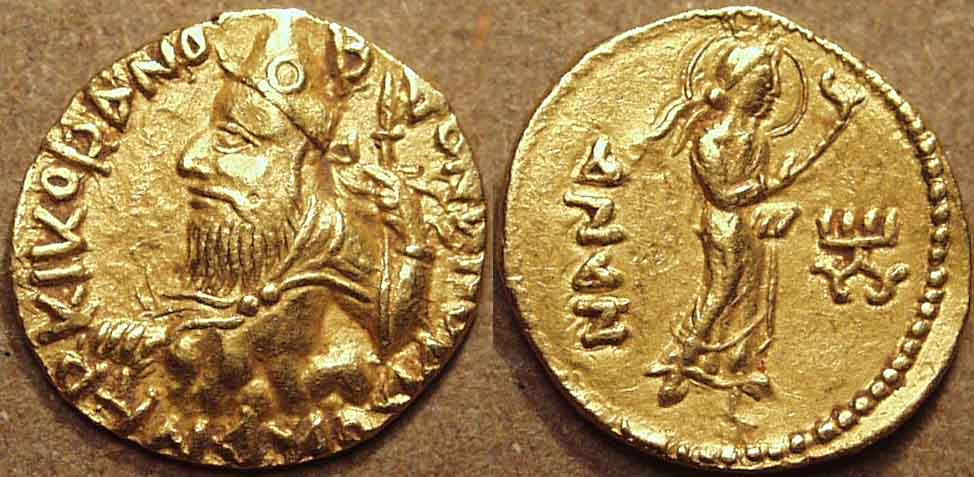
|
Gold quarter dinar, c. 128-150 CE
Weight: 1.99 gm., Diam: 13 mm., Die axis: 12 o'clock
Crowned, diademed bust of king left, holding spear with left hand,
Bactrian legend around: þAONANOþAO KANηþKI KOþANO
(King of Kings Kanishka Kushan) /
Goddess Nana standing right, nimbate, holding bowl and protome of animal,
Bactrian legend left: NANA, tamgha at right
Göbl 43 |
 |
Some rare quarter dinars of Kanishka, such as this one, depict the king as a bust rather than full-figure. On these coins,
the legend begins at 1 o'clock (rather than at 7 o'clock on the full-length portrait coins) and flows without interruption. |

|
Gold quarter dinar, c. 128-150 CE
Weight: 1.99 gm., Diam: 13 mm., Die axis: 12 o'clock
Crowned, diademed king standing facing, holding spear and sacrificing at altar at left,
Bactrian legend around: þAONANOþAO KA ... NηþKI KOþANO
(King of Kings Kanishka Kushan) /
Four-armed Oesho (Shiva?) standing facing, head turned to left, nimbate, holding various attributes,
Bactrian legend right: OηþO, tamgha at left
Göbl 51 |
 |
Notice the really tight quality control that must have been exercised in Kanishka's mints. The weight of the dinars is
normally just a few milligrams below 8 gm. and the quarter dinars also tend to cluster just below 2 gm. in weight. Note also how the die axes of the coins are almost always
right around 12 o'clock. |
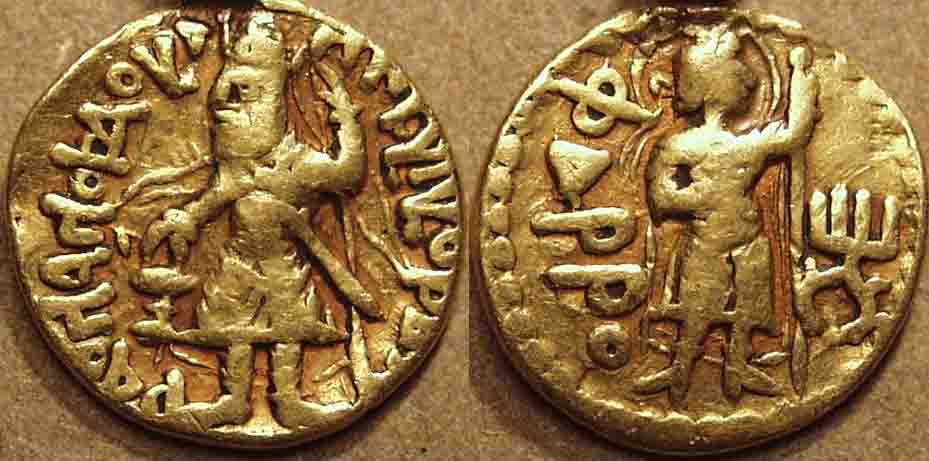
|
Gold quarter dinar, c. 128-150 CE
Weight: 1.99 gm. (including the added loop), Diam: 13 mm., Die axis: 12 o'clock
Crowned, diademed king standing facing, holding spear and sacrificing at altar at left,
Bactrian legend around: þAONANOþAO KA ... NηþKI KOþANO
(King of Kings Kanishka Kushan) /
God Pharro standing facing, head turned to right, nimbate and wearing a winged head-dress,
holding spear and bowl, Bactrian legend left: ΦAPPO, tamgha at right
Göbl 74 |
 |
Pharro was the Iranian god of royal glory and legitimacy. |
 |
 |
 |
Bactrian issues: Bronze |
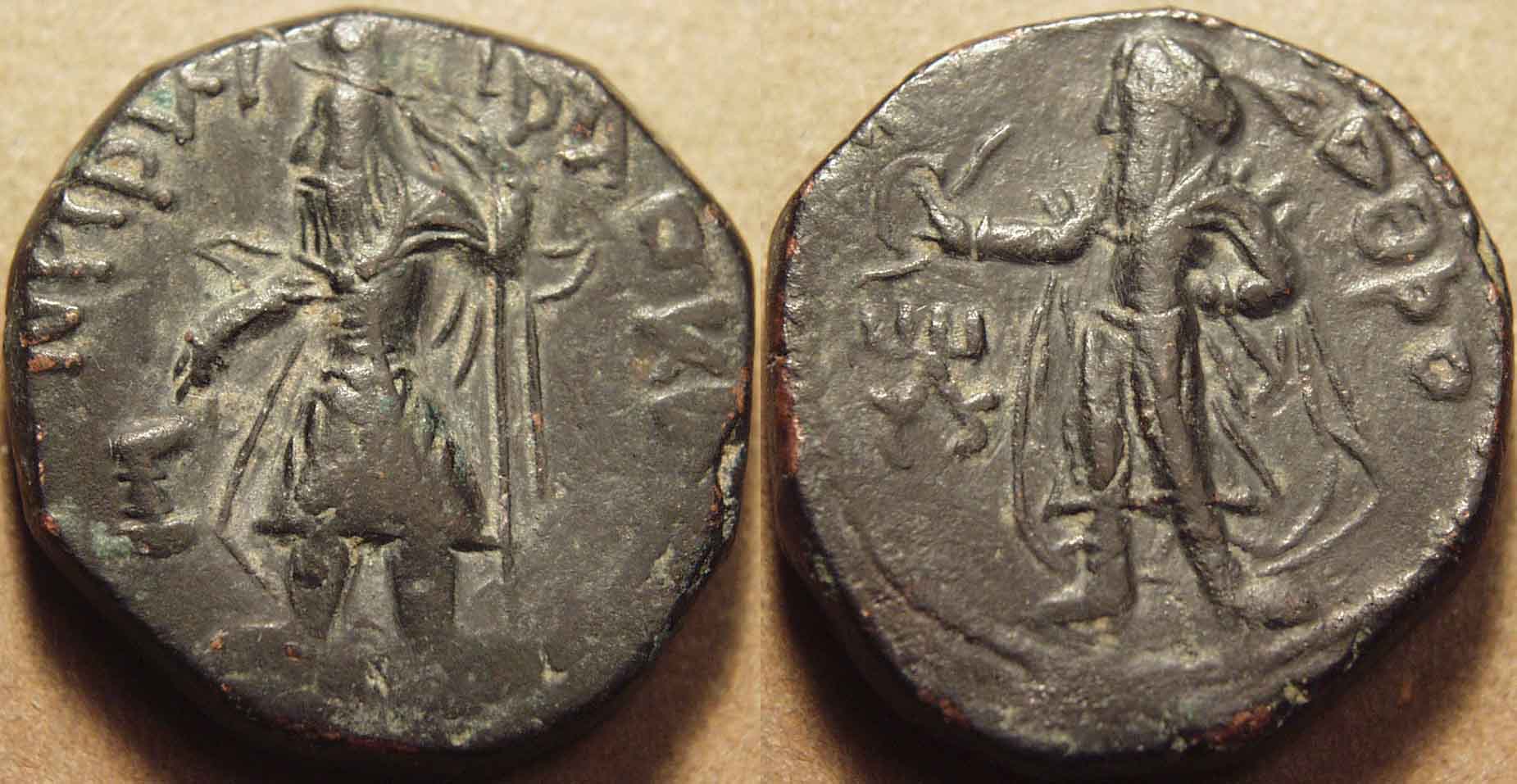
|
AE tetradrachm or unit, c. 128-150 CE
Weight: 17.26 gm., Diam: 24-25 mm., Die axis: 12 o'clock
Crowned, diademed king standing facing, holding spear and sacrificing at altar at left,
Bactrian legend around: þAO KA ... NηþKI (King Kanishka) /
God of metals Athsho standing facing, with head turned to left, one hand on hip,
the other holding out diadem, Bactrian legend right: AΘþO, tamgha at left
Göbl 772, MAC 3082-84 |
 |
The range of deities featured on Kanishka's base metal coinage is smaller than that on the gold coins. Deities known to
have appeared on Kanishka AE tetradrachms are: Ardochsho, Athsho, Buddha, Mao, Mithra, Nana, Oado, and Oesho (Shiva?) |

|
AE tetradrachm or unit, c. 128-150 CE
Weight: 16.42 gm., Diam: 25 mm., Die axis: 12 o'clock
Crowned, diademed king standing facing, holding spear and sacrificing at altar at left,
Bactrian legend around: þAO KA ... NηþKI (King Kanishka) /
Sakyamuni Buddha standing facing, left hand holding robe, right hand in abhayamudra, "have no fear,"
Bactrian legend at left and right: CAKAMAN .. O BOYΔO, tamgha at left
Göbl 786, Cribb die 5 |
 |
The bronze coinage featured both a standing Buddha type and a seated type (next coin). The Buddha coins are rare and are the most sought after
of the Kanishka bronzes. |
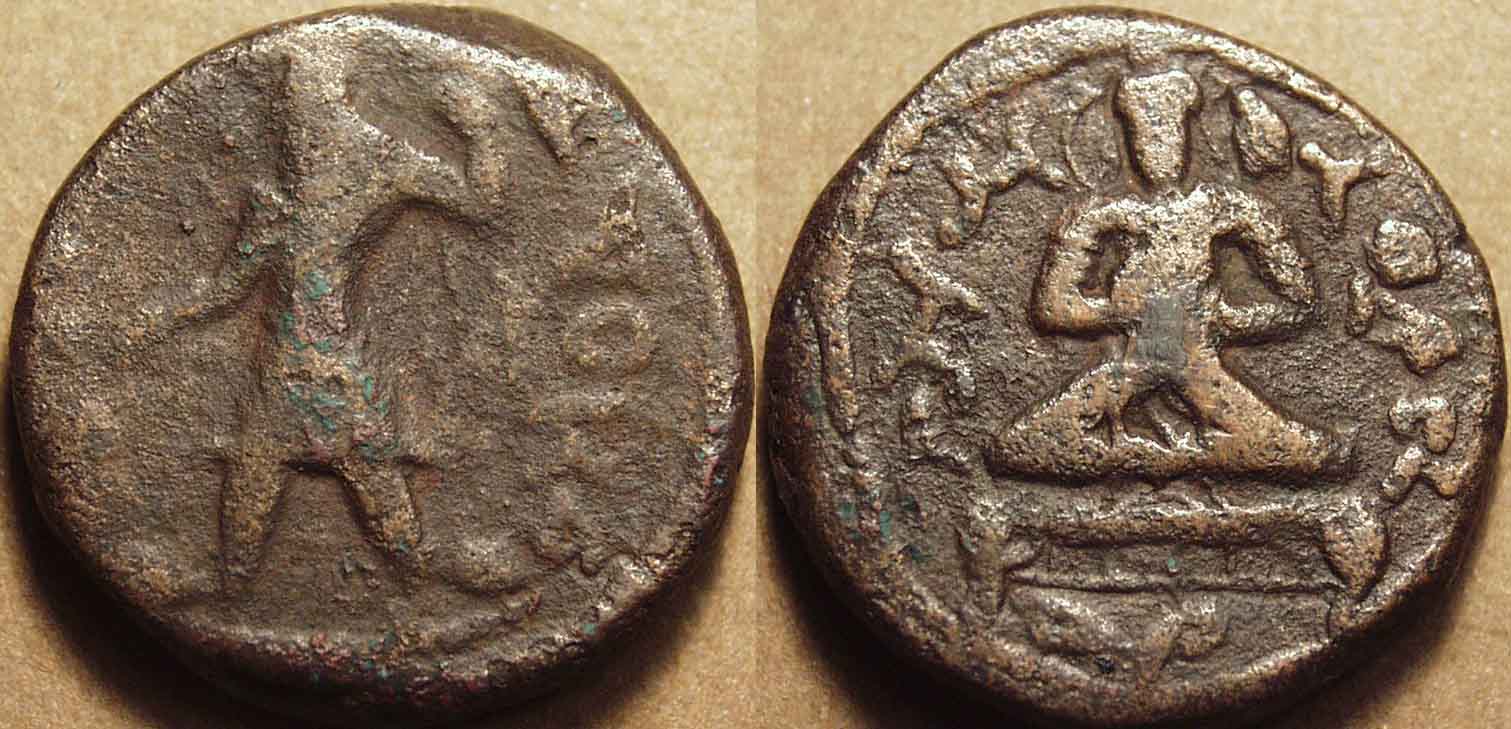
|
AE tetradrachm or unit, c. 128-150 CE
Weight: 16.28 gm., Diam: 26 mm., Die axis: 12 o'clock
Crowned, diademed king standing facing, holding spear and sacrificing at altar at left,
Bactrian legend around: þAO KA ... NηþKI (King Kanishka) /
Maitreya Buddha seated facing on a meditation platform,
Bactrian legend around: MHTPAΓO BOYΔO (letters retrograde), no tamgha
Göbl 793, Cribb die 22 |
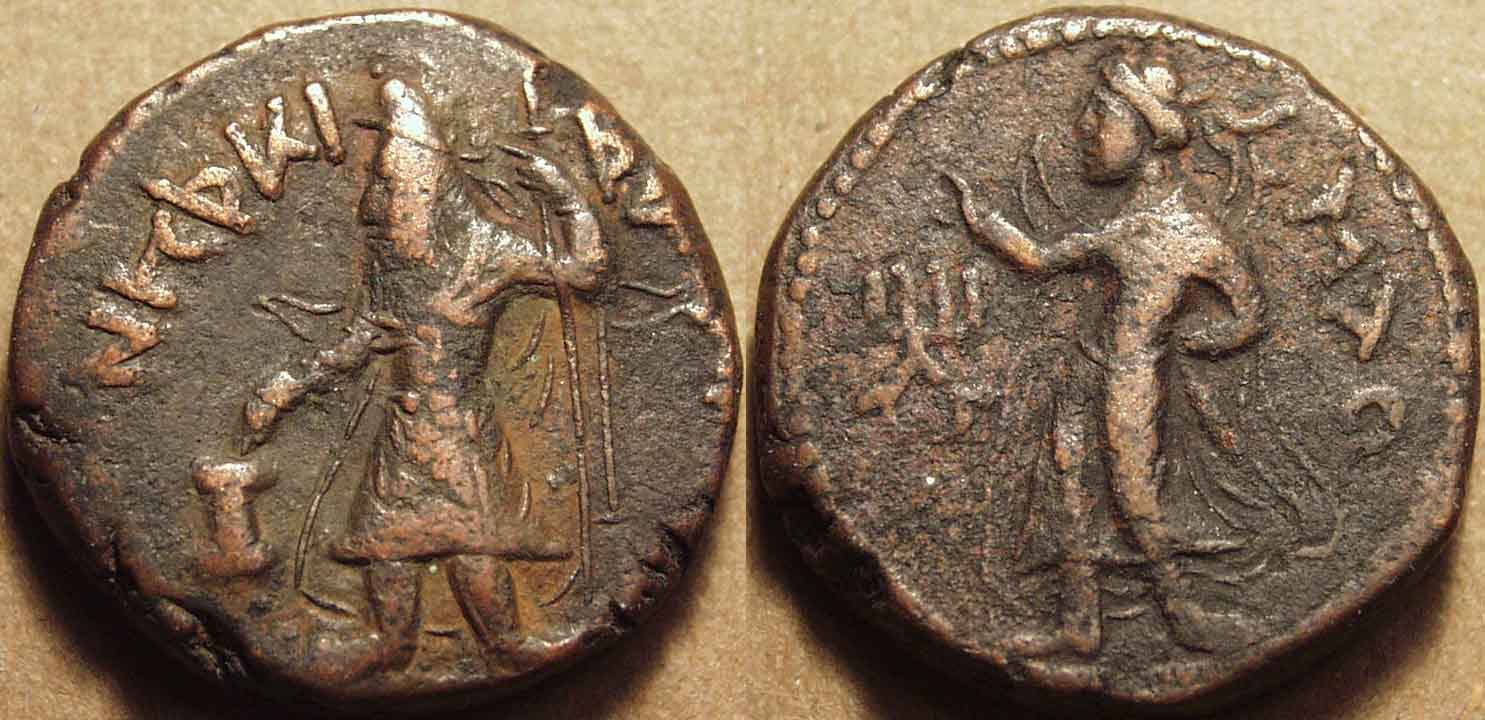
|
AE tetradrachm or unit, c. 128-150 CE
Weight: 16.88 gm., Diam: 25 mm., Die axis: 12 o'clock
Crowned, diademed king standing facing, holding spear and sacrificing at altar at left,
Bactrian legend around: þAO KA ... NηþKI (King Kanishka) /
Lunar deity Mao standing left, holding sword hilt and holding out hand in blessing,
lunar crescents on shoulders, Bactrian legend right: MAO, tamgha at left
Göbl 774, MAC 3079 |

|
AE tetradrachm or unit, c. 128-150 CE
Weight: 16.66 gm., Diam: 25-27 mm., Die axis: 1 o'clock
Crowned, diademed king standing facing, holding spear and sacrificing at altar at left,
Bactrian legend around: þAO KA ... NηþKI (King Kanishka) /
Solar deity Mithra standing left, holding sword hilt and holding out hand in blessing,
radiate nimbus around head, Bactrian legend right: MIOPO, tamgha at left
Göbl 770, MAC 3074 |
 |
For some reason, most of the bronze coins with Mithra spell his name MIOPO rather than MIIPO as is usual on the gold
coinage. See the next coin for an example of the scarcer MIIPO type. |
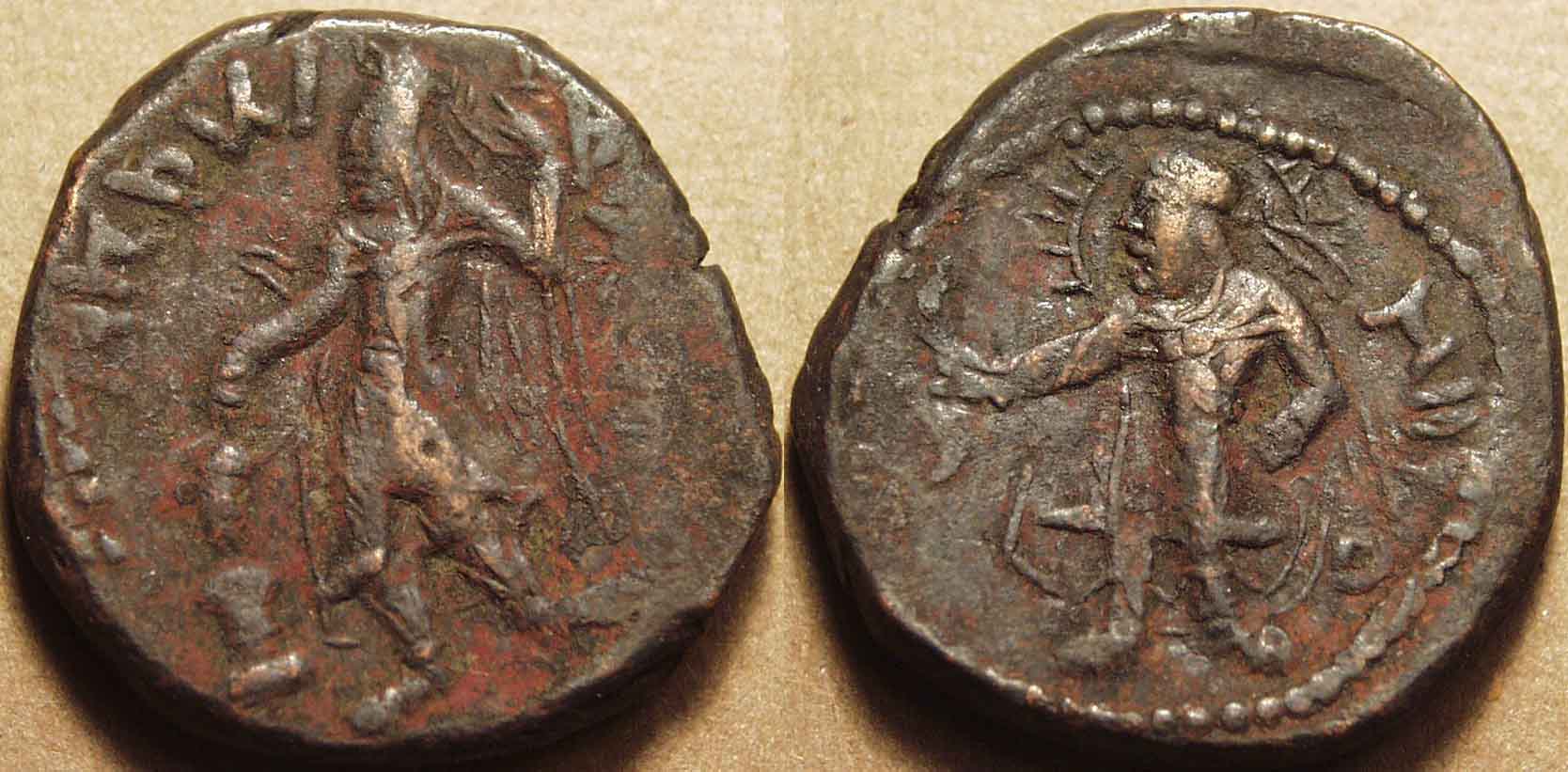
|
AE tetradrachm or unit, c. 128-150 CE
Weight: 17.37 gm., Diam: 27 mm., Die axis: 12 o'clock
Crowned, diademed king standing facing, holding spear and sacrificing at altar at left,
Bactrian legend around: þAO KA ... NηþKI (King Kanishka) /
Solar deity Mithra standing left, holding sword hilt and holding out hand in blessing,
radiate nimbus around head, Bactrian legend right: MIIPO, tamgha at left
Göbl 768, MAC 3077 |
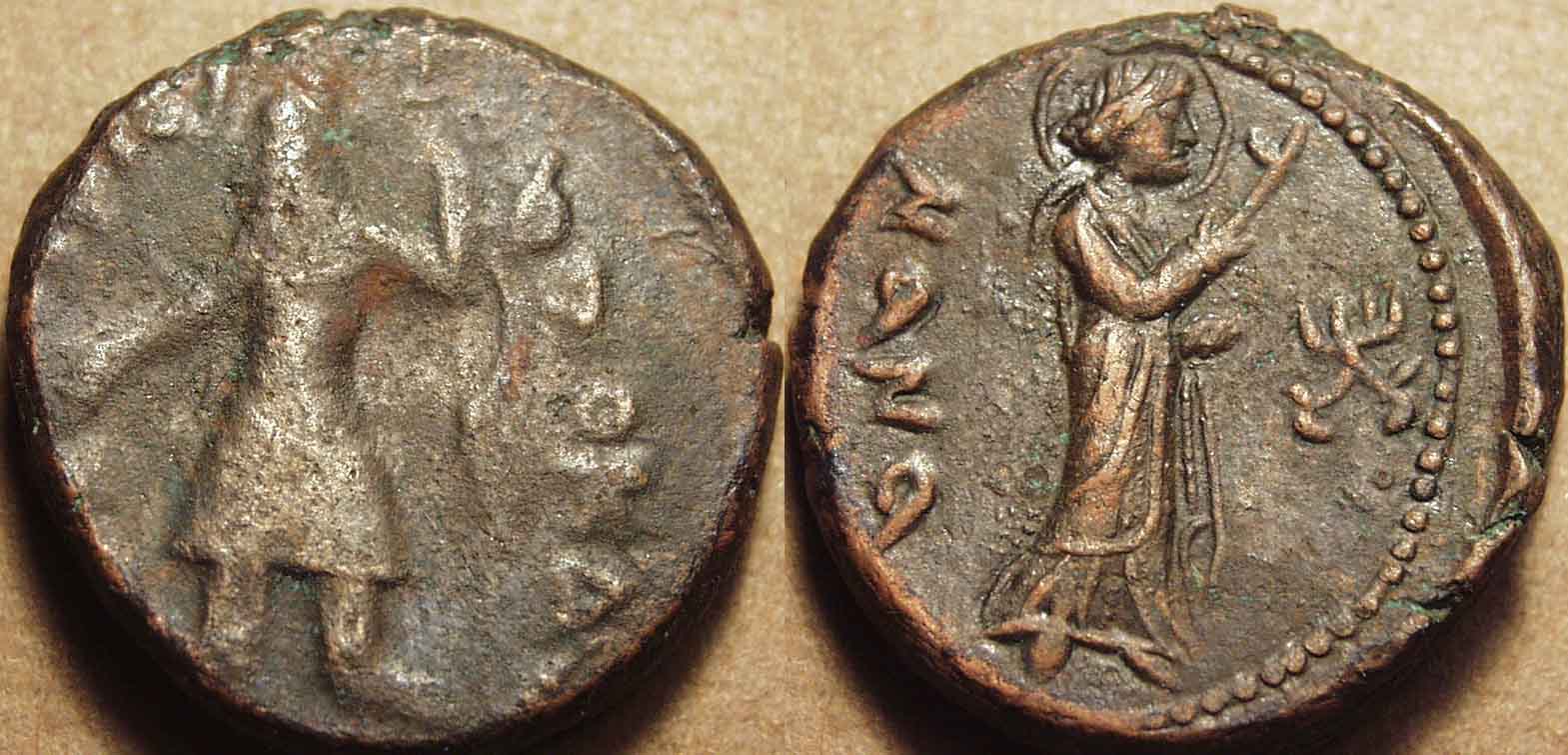
|
AE tetradrachm or unit, c. 128-150 CE
Weight: 17.06 gm., Diam: 25 mm., Die axis: 12 o'clock
Crowned, diademed king standing facing, holding spear and sacrificing at altar at left,
Bactrian legend around: þAO KA ... NηþKI (King Kanishka) /
Goddess Nana standing right, nimbate, holding bowl and protome of animal,
Bactrian legend left: NANA, tamgha at right
Göbl 777, MAC 3087 |
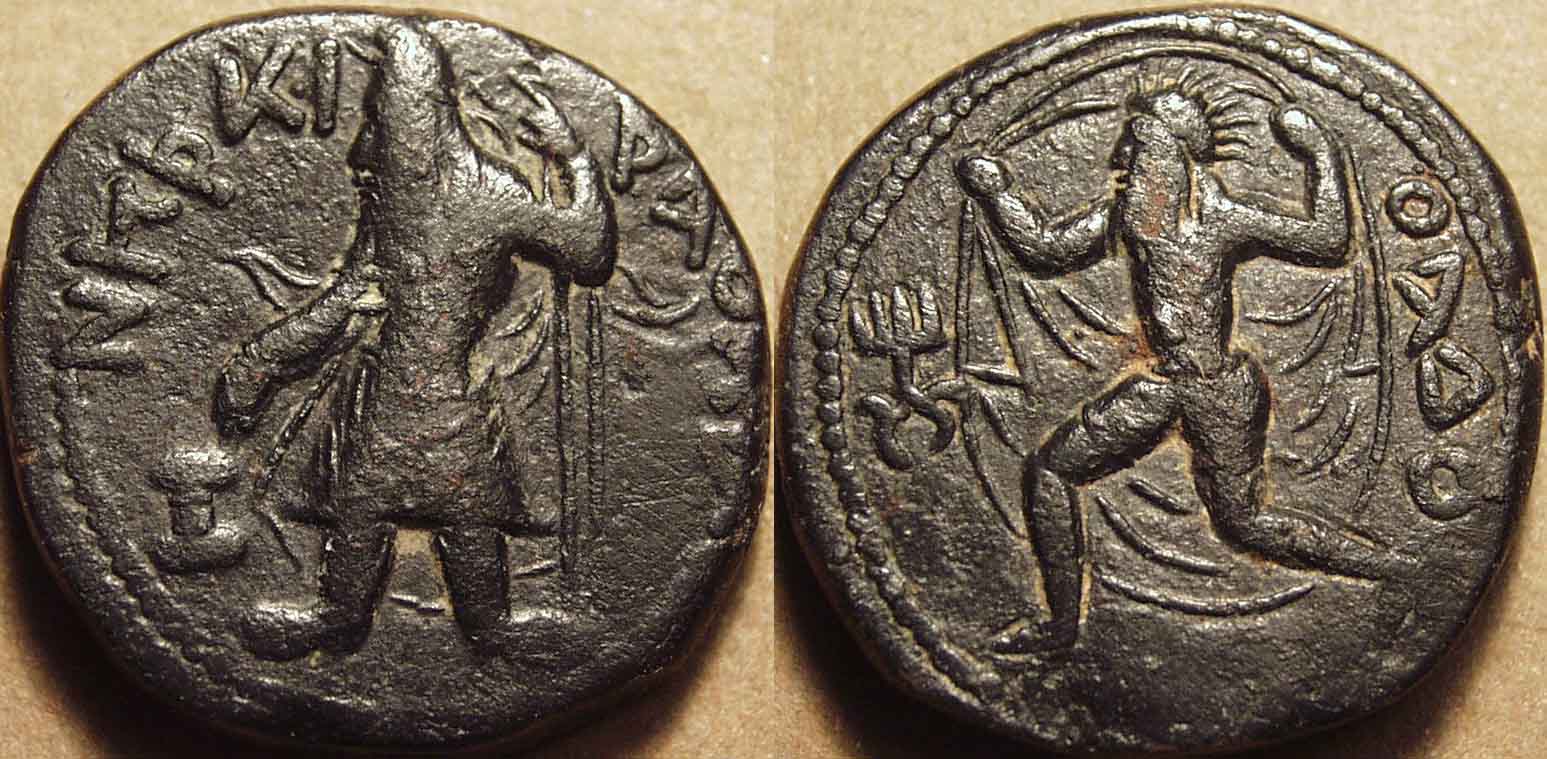
|
AE tetradrachm or unit, c. 128-150 CE
Weight: 16.75 gm., Diam: 25 mm., Die axis: 1 o'clock
Crowned, diademed king standing facing, holding spear and sacrificing at altar at left,
Bactrian legend around: þAO KA ... NηþKI (King Kanishka) /
Wind god Oado (Vado) running left, holding up cloak to represent the wind,
Bactrian legend right: OAΔO, tamgha at left
Göbl 783, MAC 3108 |
 |
Strangely, Kanishka did not issue any gold coins honoring Oado, even though he had issued coins in honor of Anemos,
the Greek equivalent and in exactly the same pose, in his Year One coinage. |
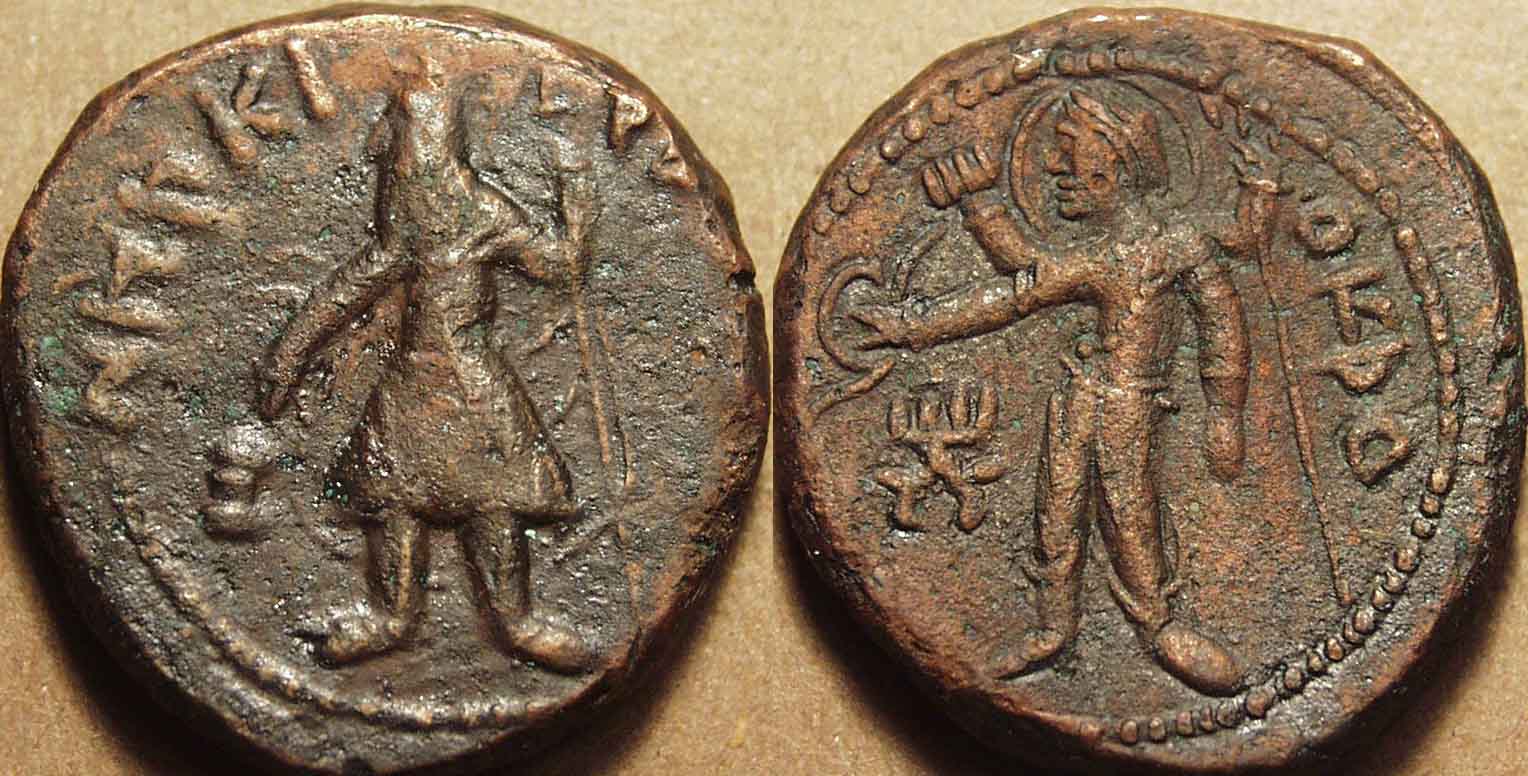
|
AE tetradrachm or unit, c. 128-150 CE
Weight: 17.13 gm., Diam: 26-27 mm., Die axis: 1 o'clock
Crowned, diademed king standing facing, holding spear and sacrificing at altar at left,
Bactrian legend around: þAO KA ... NηþKI (King Kanishka) /
Four-armed Oesho (Shiva?) standing facing, head turned to left, nimbate, holding various attributes,
Bactrian legend right: OKþO, tamgha at left
Göbl 781, MAC 3098 |
 |
The iconography of Oesho is slightly different on the bronze coins as opposed to the gold. The two upper hands are the
same: damaru in the right hand and trident in the left. But here the deerskin in the left lower hand has been eliminated and replaced by the water pot, which was in the
right lower hand on the gold issues. Instead, the right lower hand holds out a diadem, thus conveying divine authority to the king's rule. To me, this suggests that there was a
large Saivite community among the middle class, the ones most likely to use the bronze rather than the gold coinage. |
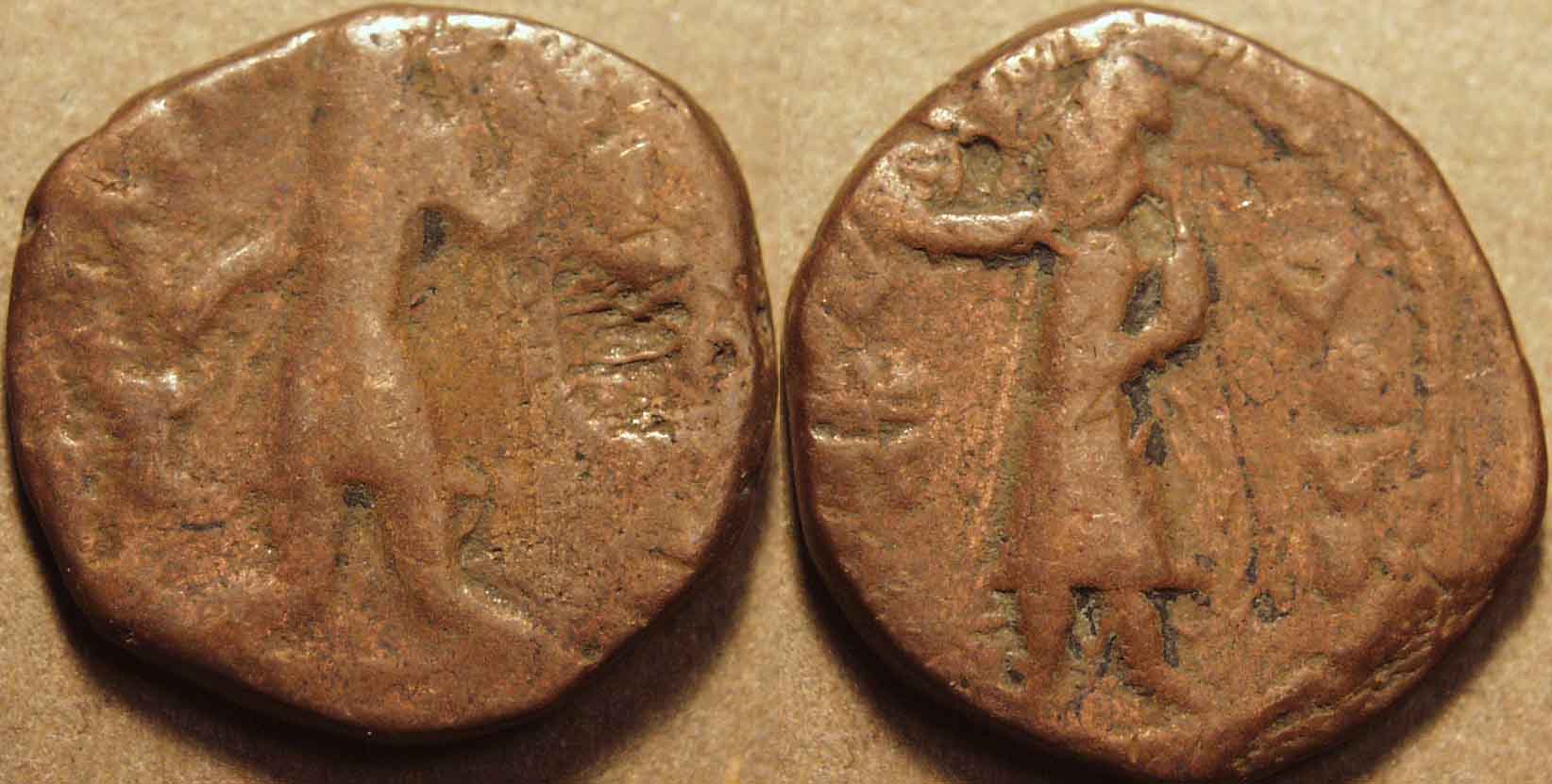
|
AE didrachm or 1/2 unit, c. 128-150 CE
Weight: 7.67 gm., Diam: 21 mm., Die axis: 11 o'clock
Crowned, diademed king standing facing, holding spear and sacrificing at altar at left,
Bactrian legend around: þAO KA ... NηþKI (King Kanishka) /
God of metals Athsho standing facing, with head turned to left, one hand on hip,
the other holding out diadem, Bactrian legend right: AΘþO, tamgha at left
Göbl 772, MAC 3082-84 |
 |
Didrachms or half units are known for: Athsho, Buddha, Mao, Mithra, Nana, Oado, and Oesho (Shiva?) |
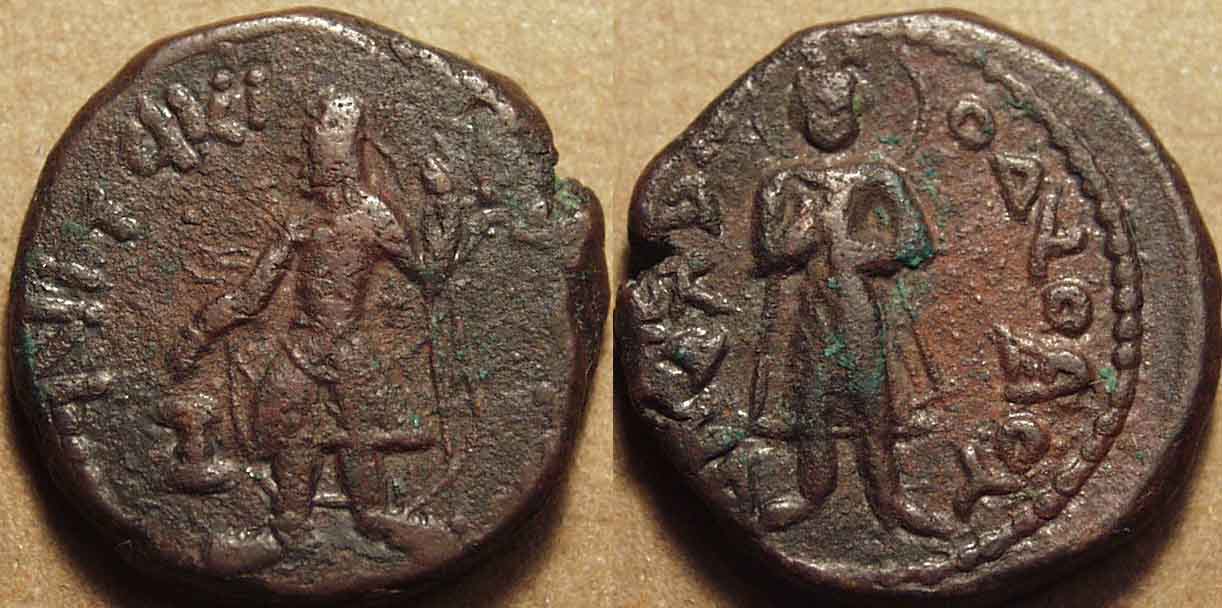
|
AE didrachm or 1/2 unit, c. 128-150 CE
Weight: 8.47 gm., Diam: 21 mm., Die axis: 1 o'clock
Crowned, diademed king standing facing, holding spear and sacrificing at altar at left,
Bactrian legend around: þAO KA ... NηþKI (King Kanishka) /
Sakyamuni Buddha standing facing, left hand holding robe, right hand in abhayamudra, "have no fear,"
Bactrian legend at left and right: CAKAMA ... NO BOYΔO, tamgha at left
Göbl 787, Cribb die 17 |
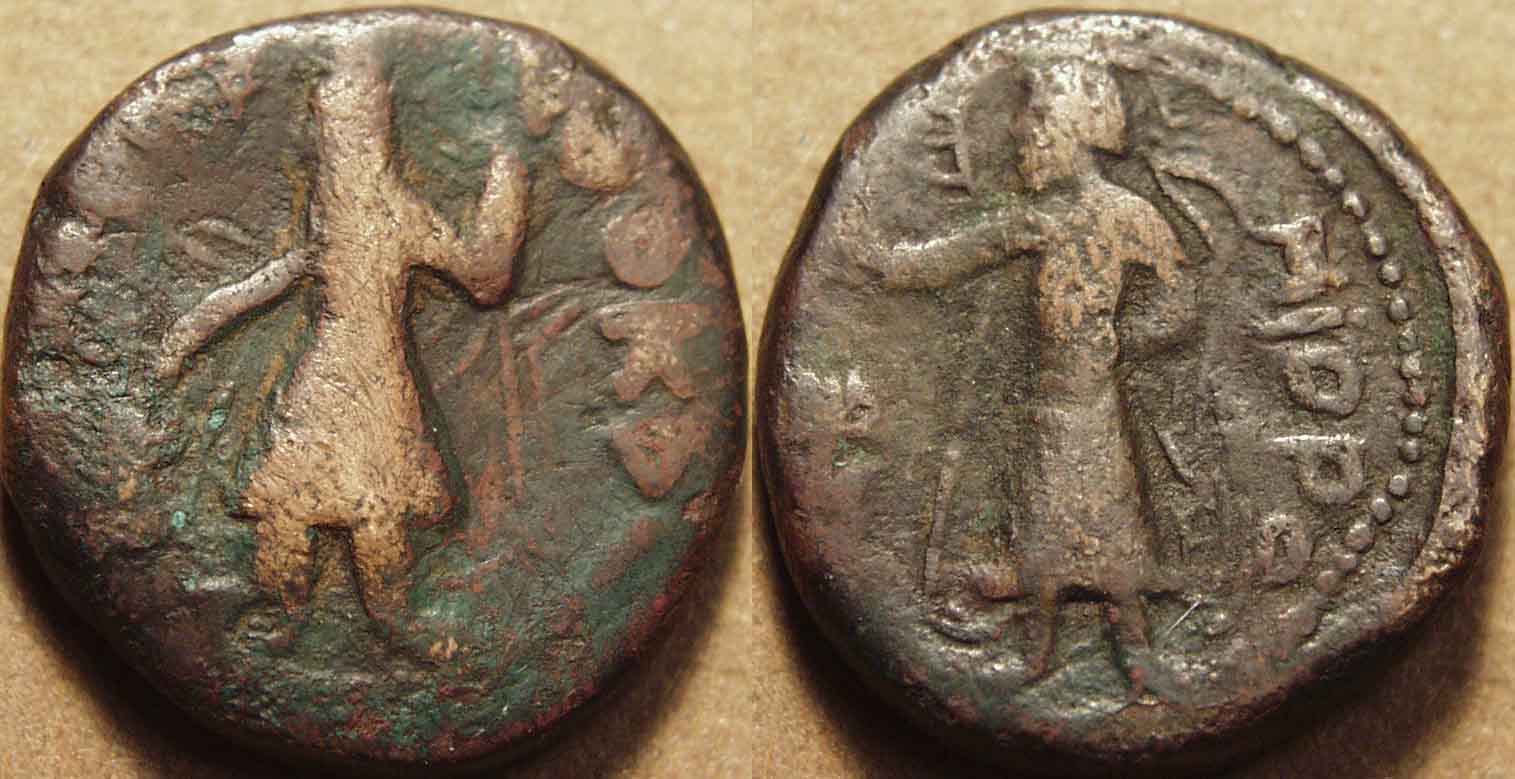
|
AE didrachm or 1/2 unit, c. 128-150 CE
Weight: 8.42 gm., Diam: 20-21 mm., Die axis: 12 o'clock
Crowned, diademed king standing facing, holding spear and sacrificing at altar at left,
Bactrian legend around: þAO KA ... NηþKI (King Kanishka) /
Solar deity Mithra standing left, holding sword hilt and holding out hand in blessing,
radiate nimbus around head, Bactrian legend right: MIOPO, tamgha at left
Göbl 771, MAC 3128 |

|
AE didrachm or 1/2 unit, c. 128-150 CE
Weight: 8.52 gm., Diam: 20-21 mm., Die axis: 12 o'clock
Crowned, diademed king standing facing, holding spear and sacrificing at altar at left,
Bactrian legend around: þAO KA ... NηþKI (King Kanishka) /
Wind god Oado (Vado) running left, holding up cloak to represent the wind,
Bactrian legend right: OAΔO, tamgha at left
Göbl 784, MAC 3135 |
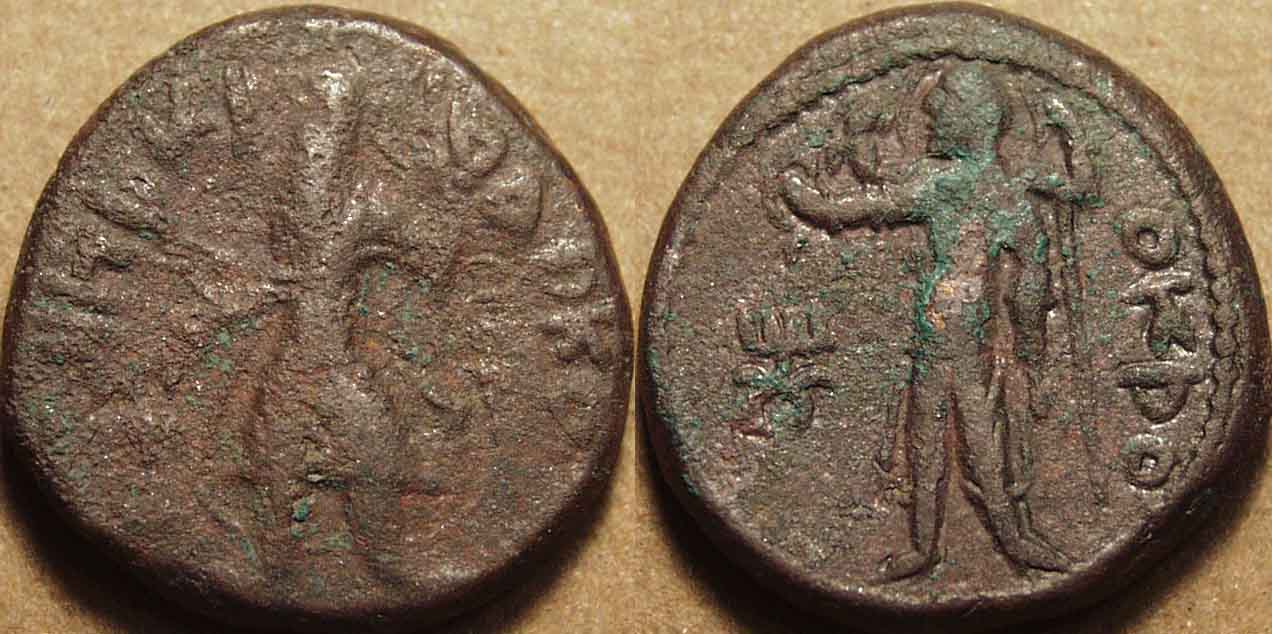
|
AE didrachm or 1/2 unit, c. 128-150 CE
Weight: 8.66 gm., Diam: 21 mm., Die axis: 12 o'clock
Crowned, diademed king standing facing, holding spear and sacrificing at altar at left,
Bactrian legend around: þAO KA ... NηþKI (King Kanishka) /
Four-armed Oesho (Shiva?) standing facing, head turned to left, nimbate, holding various attributes,
Bactrian legend right: OKþO, tamgha at left
Göbl 782, MAC 3132 |
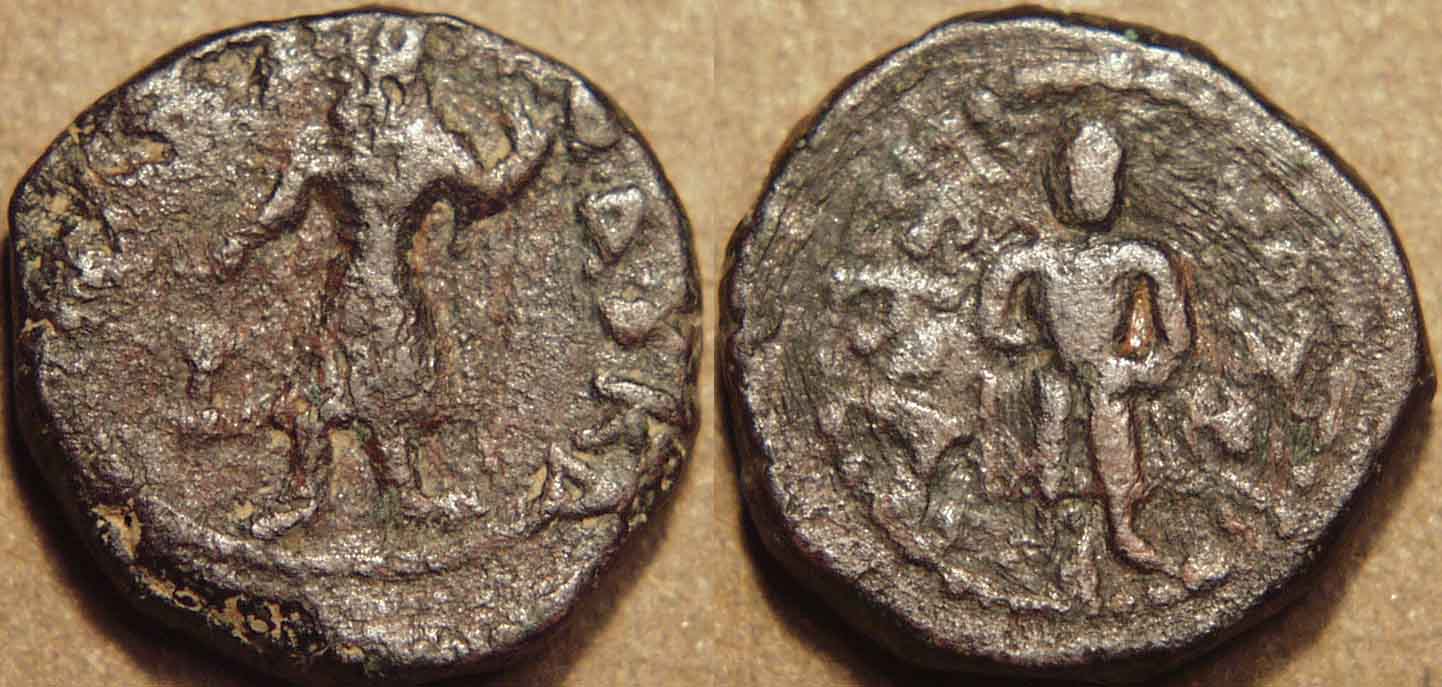
|
AE drachm or 1/4 unit, c. 128-150 CE
Weight: 5.01 gm., Diam: 16-17 mm., Die axis: 11 o'clock
Crowned, diademed king standing facing, holding spear and sacrificing at altar at left,
Bactrian legend around: þAO KA ... NηþKI (King Kanishka) /
Sakyamuni Buddha standing facing, left hand holding robe, right hand in abhayamudra, "have no fear,"
Bactrian legend at left and right: CAKAMA ... NO BOYΔO
Göbl 788, Cribb die 18 |
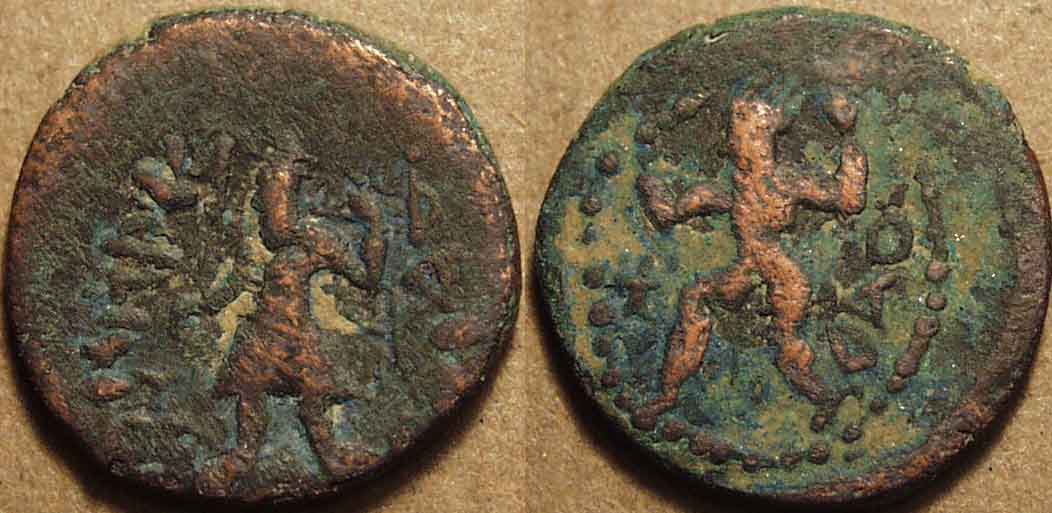
|
AE drachm or 1/4 unit, c. 128-150 CE
Weight: 5.01 gm., Diam: 18 mm., Die axis: 12 o'clock
Crowned, diademed king standing facing, holding spear and sacrificing at altar at left,
Bactrian legend around: þAO KA ... NηþKI (King Kanishka) /
Wind god Oado (Vado) running left, holding up cloak to represent the wind,
Bactrian legend right: OAΔO, tamgha at left
Göbl ---, MAC --- |
 |
Eastern "Kashmir" Series |
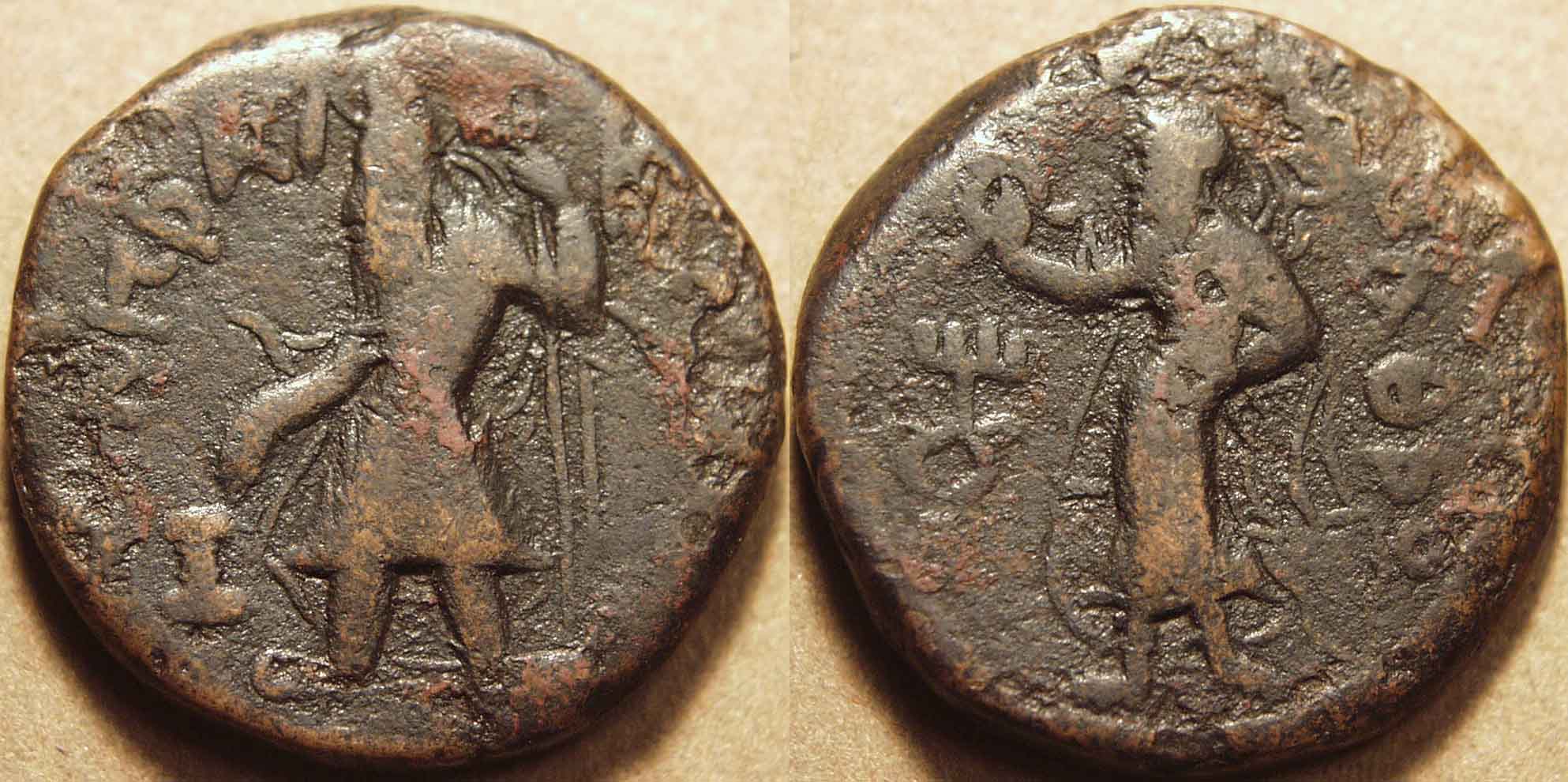
|
AE tetradrachm or unit, c. 128-150 CE
Weight: 15.92 gm., Diam: 26 mm., Die axis: 12 o'clock
Crowned, diademed king standing facing, holding spear and sacrificing at altar at left,
Bactrian legend around: þAO KA ... NηþKI (King Kanishka), tamgha at left /
God of metals Athsho standing facing, with head turned to left, one hand on hip,
the other holding out diadem, Bactrian legend right: AΘþO, tamgha at left
Göbl 795, MAC --- |
 |
An eastern mint, perhaps in Kashmir, issued a distinctive series of coins marked by the presence of a tamgha on the
obverse just to the left of the fire altar, in addition to the normal tamgha on the reverse. After an intial issue (only coins naming Athsho and Miiro are known ... this coin is the
Athsho type) which looked like the issues from the main mint, the eastern mint developed a highly idiosyncratic and attractive style ... see the following five coins. The range of
deities known to have appeared on these tetradrachms are: Mao, Mithra, Nana, Oado, and Oesho (Shiva?) |
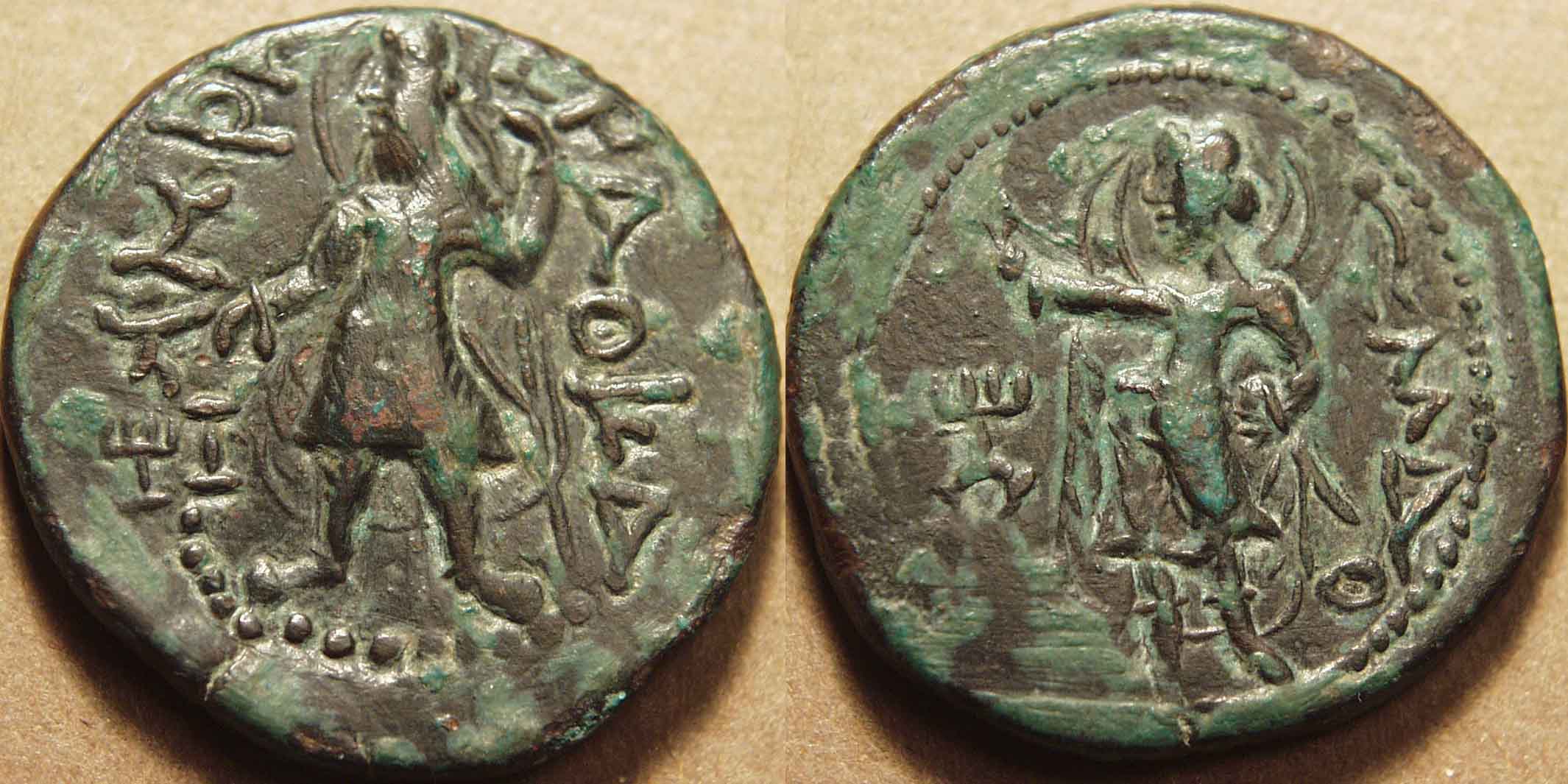
|
AE tetradrachm or unit, c. 128-150 CE
Weight: 16.35 gm., Diam: 28-29 mm., Die axis: 12 o'clock
Crowned, diademed king standing facing, holding spear and sacrificing at altar at left,
Bactrian legend around: þAO KA ... NηþKI (King Kanishka), tamgha at left /
Lunar deity Mao standing left, holding sword hilt and holding out hand in blessing,
lunar crescents on shoulders, Bactrian legend right: MAO, tamgha at left
Göbl 801, MAC 3155 |

|
AE tetradrachm or unit, c. 128-150 CE
Weight: 16.38 gm., Diam: 25-26 mm., Die axis: 11 o'clock
Crowned, diademed king standing facing, holding spear and sacrificing at altar at left,
Bactrian legend around: þAO KA ... NηþKI (King Kanishka), tamgha at left /
Solar deity Mithra standing left, holding sword hilt and holding out hand in blessing,
radiate nimbus around head, Bactrian legend right: MIIPO, tamgha at left
Göbl 796, MAC 3154 |
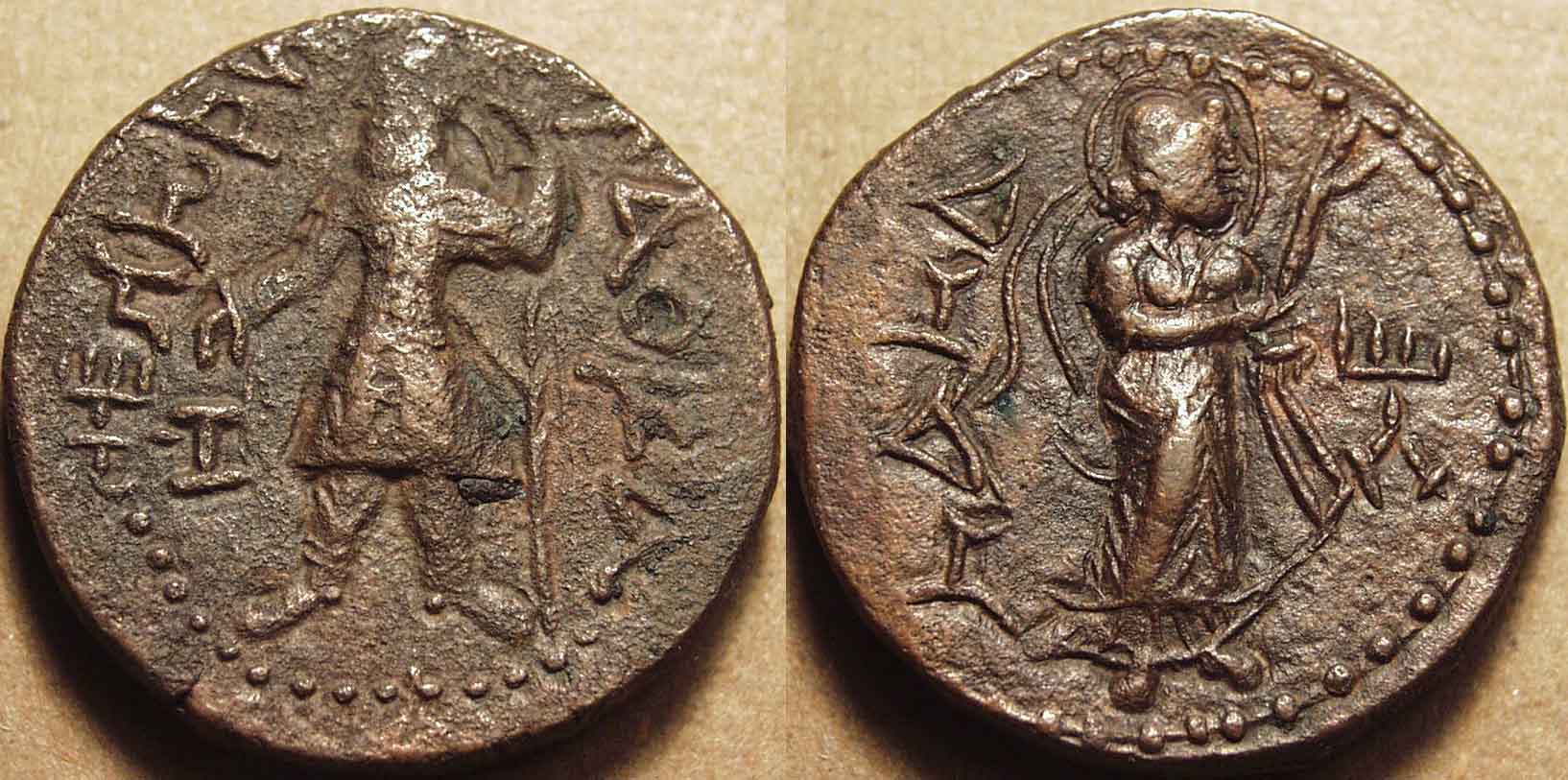
|
AE tetradrachm or unit, c. 128-150 CE
Weight: 16.01 gm., Diam: 26-27 mm., Die axis: 12 o'clock
Crowned, diademed king standing facing, holding spear and sacrificing at altar at left,
Bactrian legend around: þAO KA ... NηþKI (King Kanishka), tamgha at left /
Goddess Nana standing right, nimbate, holding bowl and protome of animal,
Bactrian legend left: NANA, tamgha at right
Göbl 805, MAC --- |
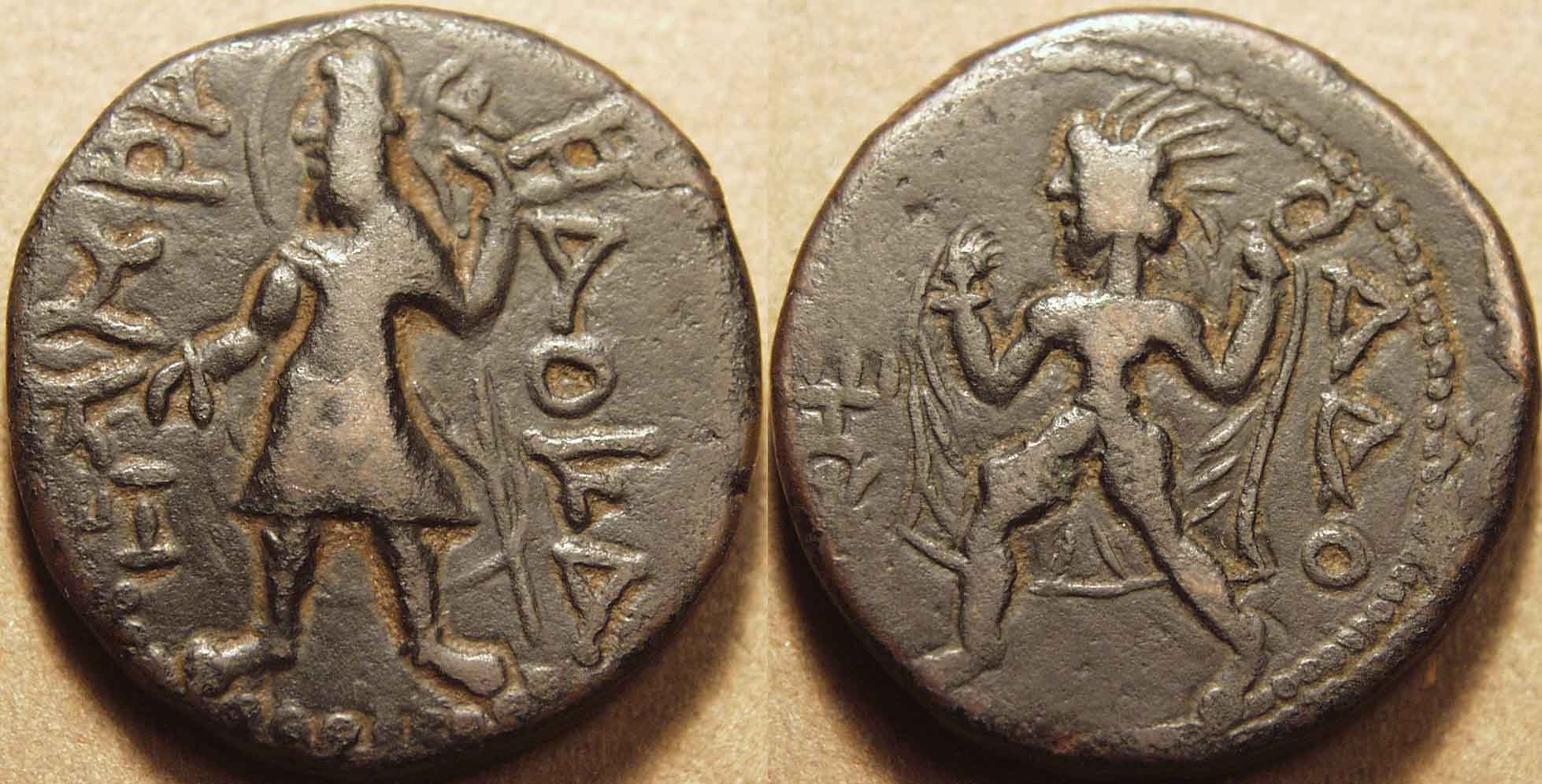
|
AE tetradrachm or unit, c. 128-150 CE
Weight: 16.34 gm., Diam: 25-27 mm., Die axis: 11 o'clock
Crowned, diademed king standing facing, holding spear and sacrificing at altar at left,
Bactrian legend around: þAO KA ... NηþKI (King Kanishka), tamgha at left /
Wind god Oado (Vado) running left, holding up cloak to represent the wind,
Bactrian legend right: OAΔO, tamgha at left
Göbl 816, MAC --- |
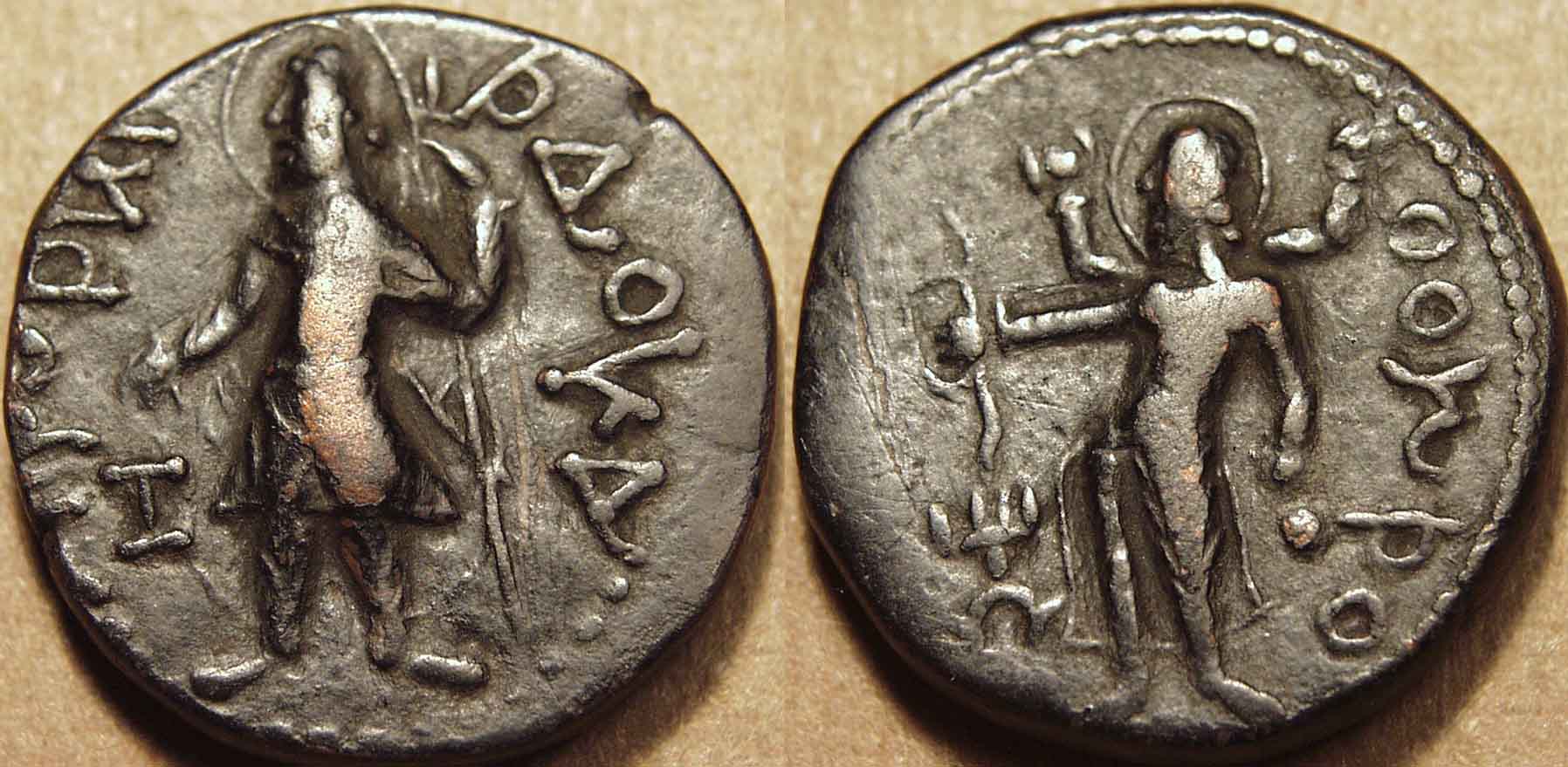
|
AE tetradrachm or unit, c. 128-150 CE
Weight: 15.99 gm., Diam: 25-26 mm., Die axis: 12 o'clock
Crowned, diademed king standing facing, holding spear and sacrificing at altar at left,
Bactrian legend around: þAO KA ... NηþKI (King Kanishka), tamgha at left /
Four-armed Oesho (Shiva?) standing facing, head turned to left, nimbate, holding various attributes,
Bactrian legend right: OOηþO, tamgha at left
Göbl 812, MAC 3156-57 |
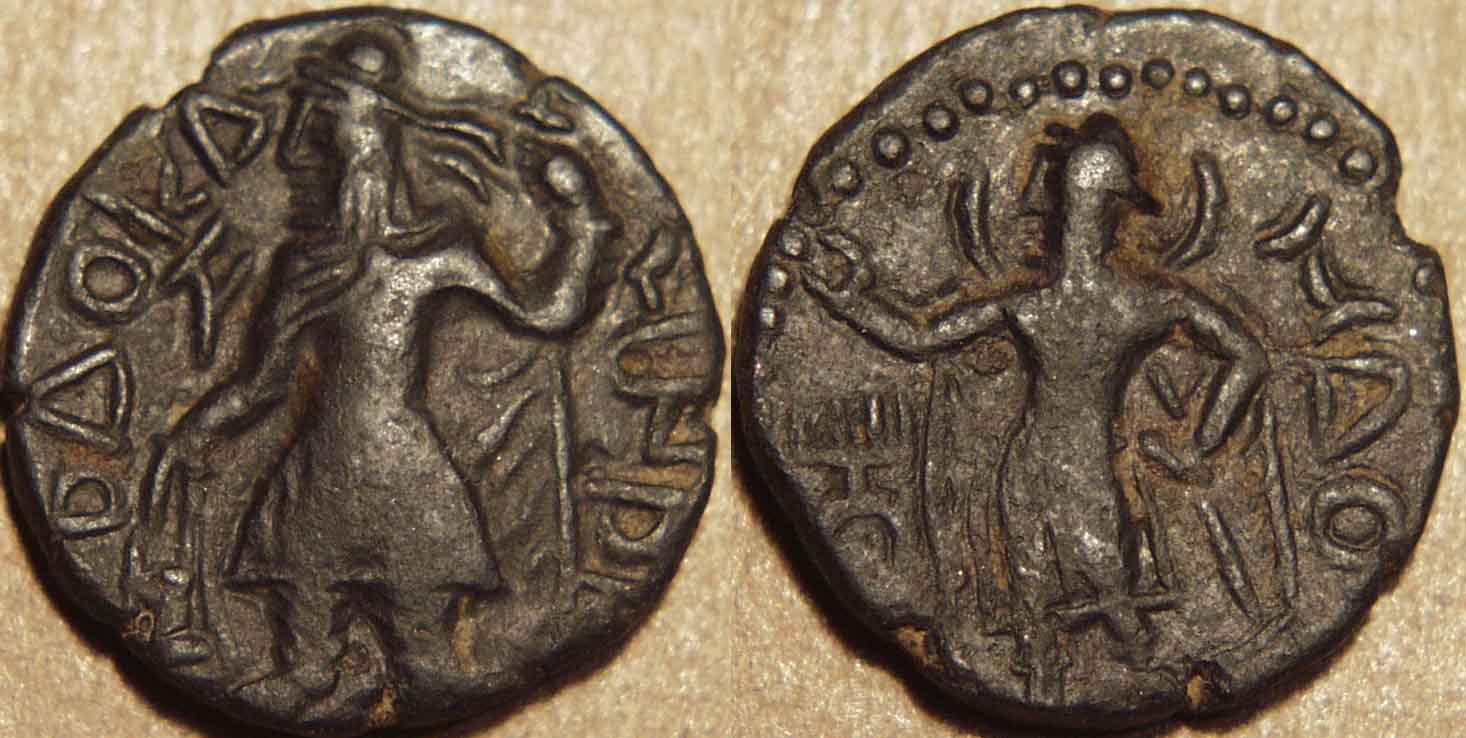
|
AE drachm or 1/4 unit, c. 128-150 CE
Weight: 3.74 gm., Diam: 17 mm., Die axis: 11 o'clock
Crowned, diademed king standing facing, holding spear and sacrificing at altar at left,
Bactrian legend around: þAO KA ... NηþKI (King Kanishka), /
Lunar deity Mao standing left, holding sword hilt and holding out hand in blessing,
lunar crescents on shoulders, Bactrian legend right: MAO, tamgha at left
Göbl 802, MAC 3161 |

|
AE drachm or 1/4 unit, c. 128-150 CE
Weight: 4.81 gm., Diam: 17 mm., Die axis: 12 o'clock
Crowned, diademed king standing facing, holding spear and sacrificing at altar at left,
Bactrian legend around: þAO KA ... NηþKI (King Kanishka), /
Solar deity Mithra standing left, holding sword hilt and holding out hand in blessing,
radiate nimbus around head, Bactrian legend right: MIYPO, tamgha at left
Göbl 797, MAC 3158-60 |
 |
The Eastern drachms, like this one, seem to mostly spell Mithra's name as MIYPO, rather than MIIPO or MIOPO. The
next coin, a rare unpublished type, has yet another version of the name: MIPAO (Mishao)! We know it is meant to represent Mithra because of the radiate nimbus. |

|
AE drachm or 1/4 unit, c. 128-150 CE
Weight: 4.48 gm., Diam: 17-19 mm., Die axis: 11 o'clock
Crowned, diademed king standing facing, holding spear and sacrificing at altar at left,
Bactrian legend around: þAO KA ... NηþKI (King Kanishka), /
Solar deity Mithra standing left, holding sword hilt and holding out hand in blessing,
radiate nimbus around head, Bactrian legend right: MIþAO, tamgha at left
Göbl ---, MAC --- |

|
AE drachm or 1/4 unit, c. 128-150 CE
Weight: 4.39 gm., Diam: 16-17 mm., Die axis: 11 o'clock
Crowned, diademed king standing facing, holding spear and sacrificing at altar at left,
Bactrian legend around: þAO ... þAη ! (King Kanishka), /
Goddess Nana standing right, nimbate, holding bowl and protome of animal,
Bactrian legend left: NANA, tamgha at right
Göbl 806, MAC 3166-67 |
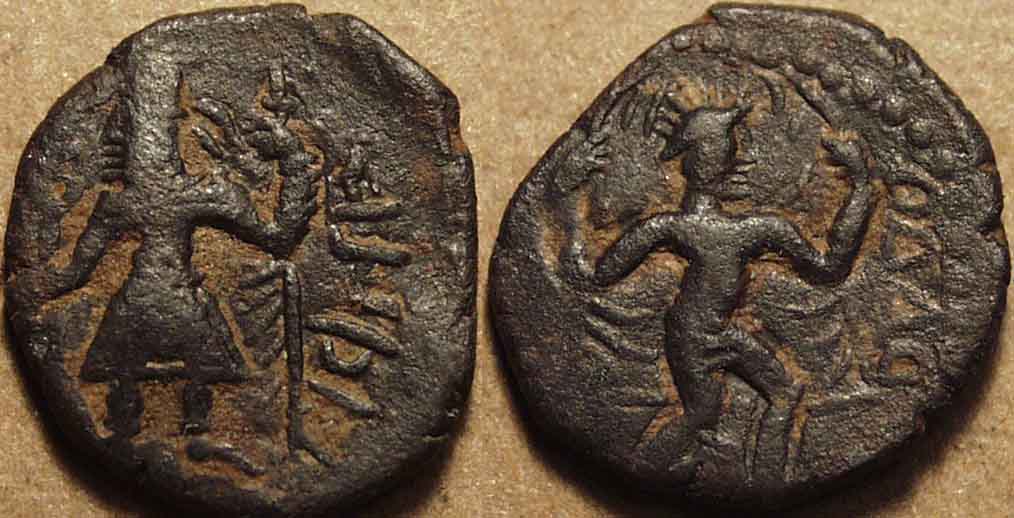
|
AE drachm or 1/4 unit, c. 128-150 CE
Weight: 3.07 gm., Diam: 16-18 mm., Die axis: 11 o'clock
Crowned, diademed king standing facing, holding spear and sacrificing at altar at left,
Bactrian legend around: þAO ... þAη ! (King Kanishka), /
Wind god Oado (Vado) running right, holding up cloak to represent the wind,
Bactrian legend right: OAΔO, tamgha at left
Göbl 819, MAC 3174 |
 |
This is the only type in which Oado runs to the right. Note also the streaming hair, seen on all the Oado coins, meant to demonstrate
the presence of a strong wind. |

|
AE drachm or 1/4 unit, c. 128-150 CE
Weight: 4.37 gm., Diam: 16-17 mm., Die axis: 11 o'clock
Crowned, diademed king standing facing, holding spear and sacrificing at altar at left,
Bactrian legend around: þAO ... þAη ! (King Kanishka), /
Two-armed ithyphallic Oesho (Shiva?) standing facing, head turned to left, nimbate,
holding various attributes, Bactrian legend right: OOηþO, tamgha at left
Göbl 813, MAC 3168 |
 |
The low denomination Eastern bronzes are the only Kanishka ones to show Oesho with only two arms; all other coins
show him with four. This coin has another interesting and novel feature ... it shows Oesho with a prominent erection, a feature also seen on some of Vima Kadphises's coins. |
|
|